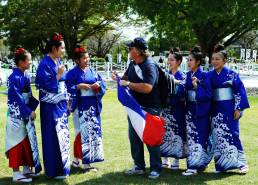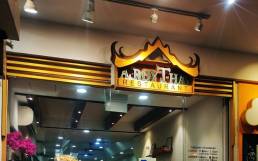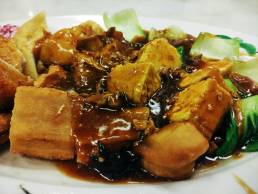I travel not to go anywhere, but to go. I travel for travel’s sake. The great affair is to move. – Robert Louis Stevenson, 1879
I have always been fascinated by overland train travel and when Laos reopened its border to tourists in May 2022, the idea of taking its newly-opened high-speed railway was formed in my mind.
With leave days to clear in my old job before my upcoming new role as well as the blessing of Mrs, I decided to embark on an overland journey through four Southeast Asian countries, with the ultimate aim of reaching Boten, Laos’ border town with China.
Segment 1: Singapore to Kuala Lumpur
A journey of a thousand miles (more like 1,800 miles in this case) begins with a single step and mine was getting to Golden Mile Tower to board the 1.30pm coach to Kuala Lumpur.

I wished that I could take the trains all the way but to travel between Singapore and Kuala Lumpur by trains was simply too much hassle these days. Things will change when KTM completes its double-tracking project in Johor (hopefully by October 2022) but in the meantime, the coach will be faster and more hassle-free.
The bus ticket was booked online the day before, costing 30 SGD (21.60 USD). I was required to verify my booking at the office and the staff informed me to wait for the bus outside.
 The coach arrived at 1.26pm and I was surprised to see passengers coming from Kuala Lumpur alighting. I later learned that the original bus had broken down and the replacement bus had to do an immediate turnaround back to Malaysia.
The coach arrived at 1.26pm and I was surprised to see passengers coming from Kuala Lumpur alighting. I later learned that the original bus had broken down and the replacement bus had to do an immediate turnaround back to Malaysia.

I boarded and settled into seat 01.

Service: Starmart Express
Depart: Golden Mile Tower, Singapore 1:30pm
Arrive: Berjaya Times Square, Kuala Lumpur 7:30pm
Duration: ~6h0m
Distance: ~370km
Vehicle model / registration: Volvo B11R / AKQ 15
Cost: 30 SGD (21.60 USD)
Despite the confusion arising from the newly allocated seat numbers, the bus departed only 15 minutes after the original scheduled departure time.
The Singapore leg of this journey took only half an hour and most passengers breezed through Singapore’s exit immigration control.
It was my first time crossing over Second Link into Malaysia after two long years of COVID-19 pandemic. Forest City development could be spotted in a distance.

I managed to clear the Malaysian immigration within five minutes of arrival and no proof of vaccination was requested. However, the Malaysian immigration control presented some problems for an Indian family traveling on the same coach and they took close to an hour to be cleared to enter Malaysia. It meant that I had plenty of time to observe the closed shops at the waiting point.
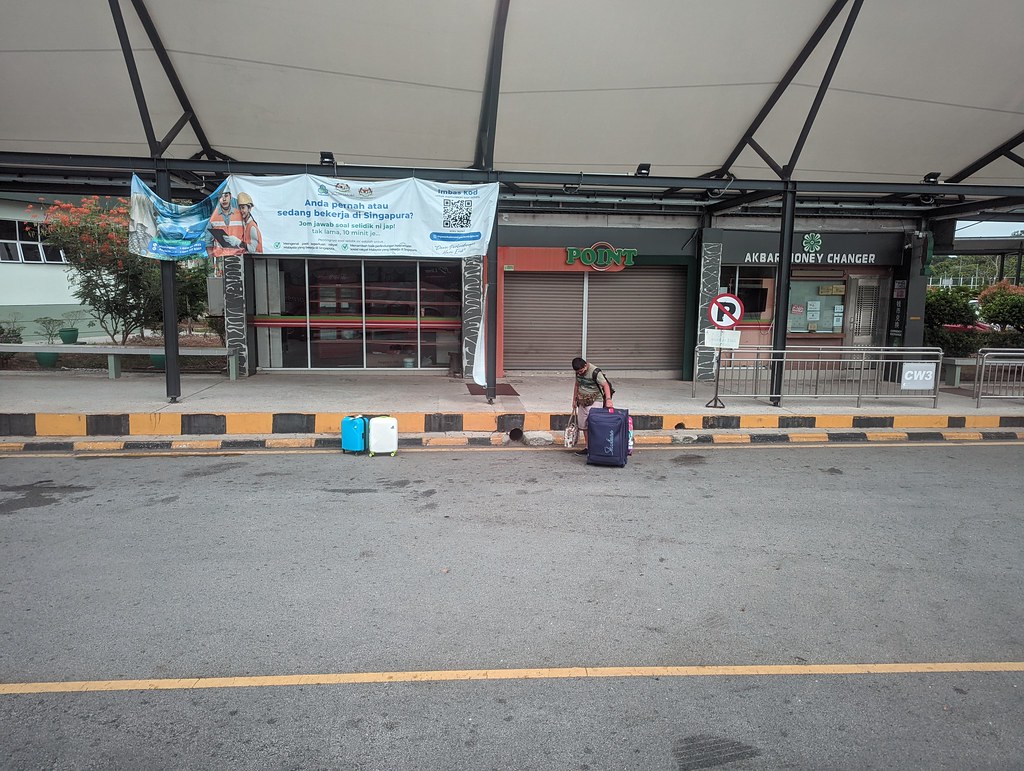
Our coach only got going from Malaysian CIQ at around 3.35pm, almost two hours since departing Golden Mile Tower. The driver kept driving for the next three hours until we reached Nilai R&R where we had a bathroom break.

It was sunset time when we were driving into the heavy Klang Valley traffic.
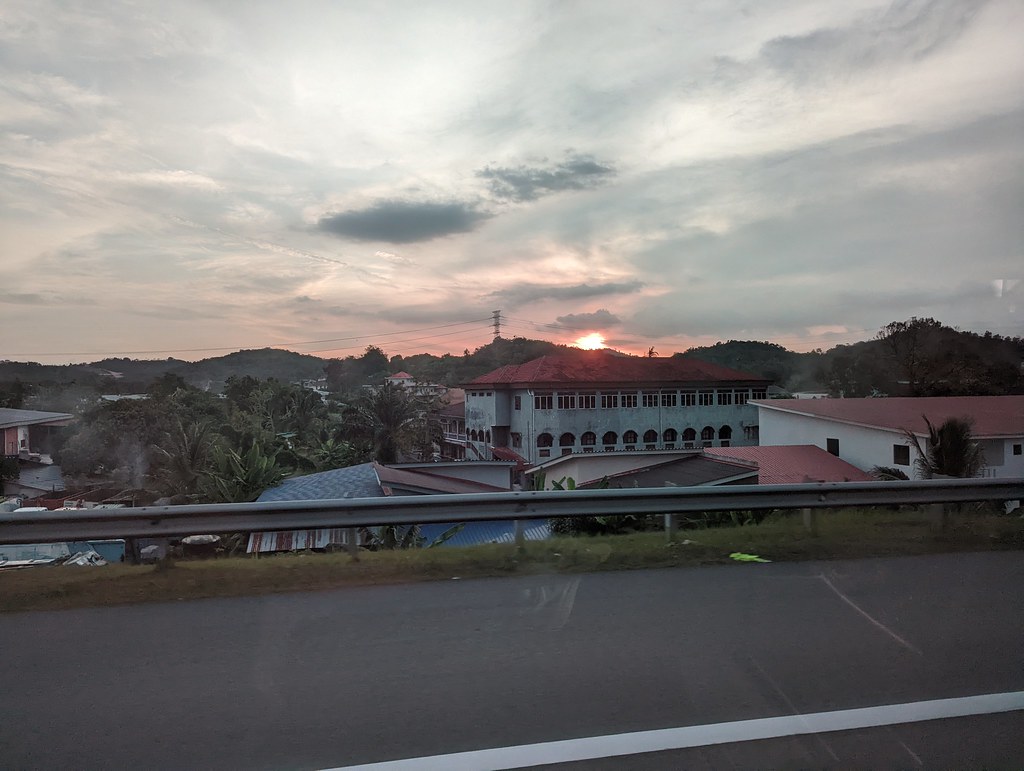
Despite the delay, we rolled into Terminal Bersepadu Selatan at the scheduled arrival time of 7.30pm and some of the passengers alighted.

Fifteen minutes later, I alighted at the second stop of Berjaya Times Square and decided to have a quick dinner at Nando’s (27.90 MYR or 6.32 USD). How apt to have chicken for dinner on the first day of Malaysia’s ban on chicken exports to Singapore.

While traveling on the coach, I’ve booked my accommodation for the night. Mercure KL Shaw Parade was a block away from where I alighted and the cost was a very reasonable 50.14 SGD (36 USD).
The room was pretty nice and I couldn’t complain at this cost.

It also has a small rooftop pool.
And of course I couldn’t leave Kuala Lumpur without a shot of Petronas Towers and KL’s cityscape.

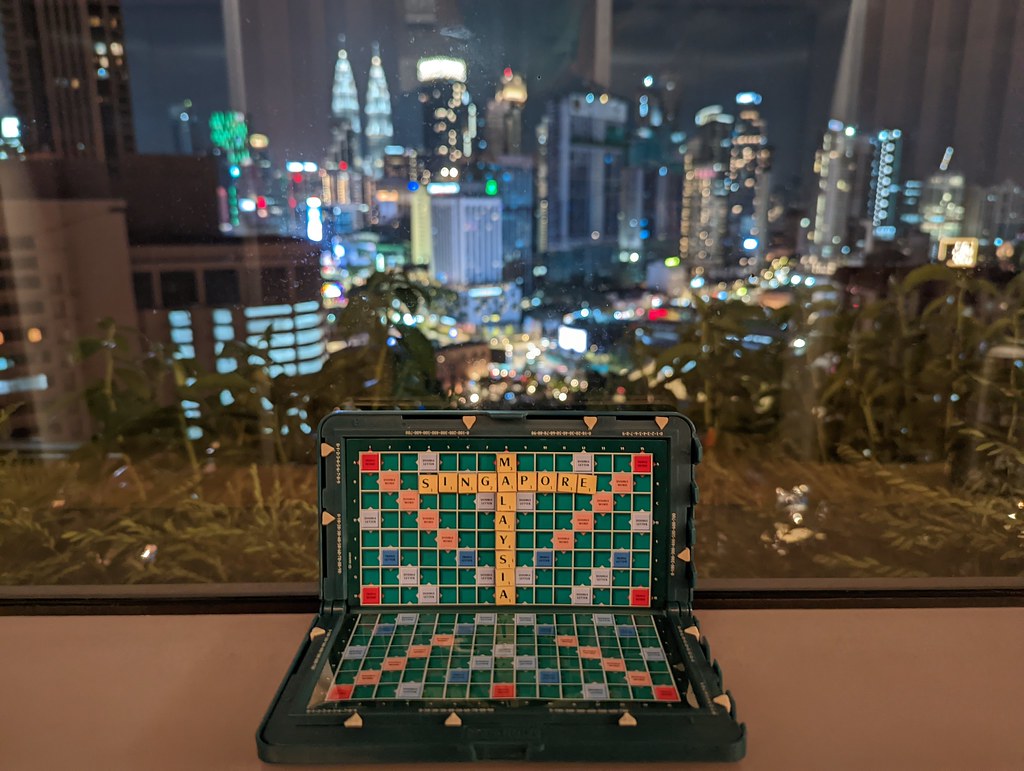
Distance travelled so far: ~ 370km
Segment 2: Kuala Lumpur to Hat Yai
Despite being in Bukit Bintang, Mercure KL Shaw Parade isn’t located in the most glamorous location.

It was an early start and a 15-minute Grab ride (10 MYR or 2.26 USD) brought me to KL Sentral where the next leg of journey would begin. It wasn’t too difficult to locate the departure gate.

The first round of check was conducted around half an hour before departure by security officers who verified the passengers’ vaccination status on MySejahtera app. The second round required passengers to scan the barcode on their tickets in order to access the platform through the turnstiles. While waiting in line, I noticed that KTM operated the Ruby Lounge for the business class passengers. However, I had no idea how to access it.
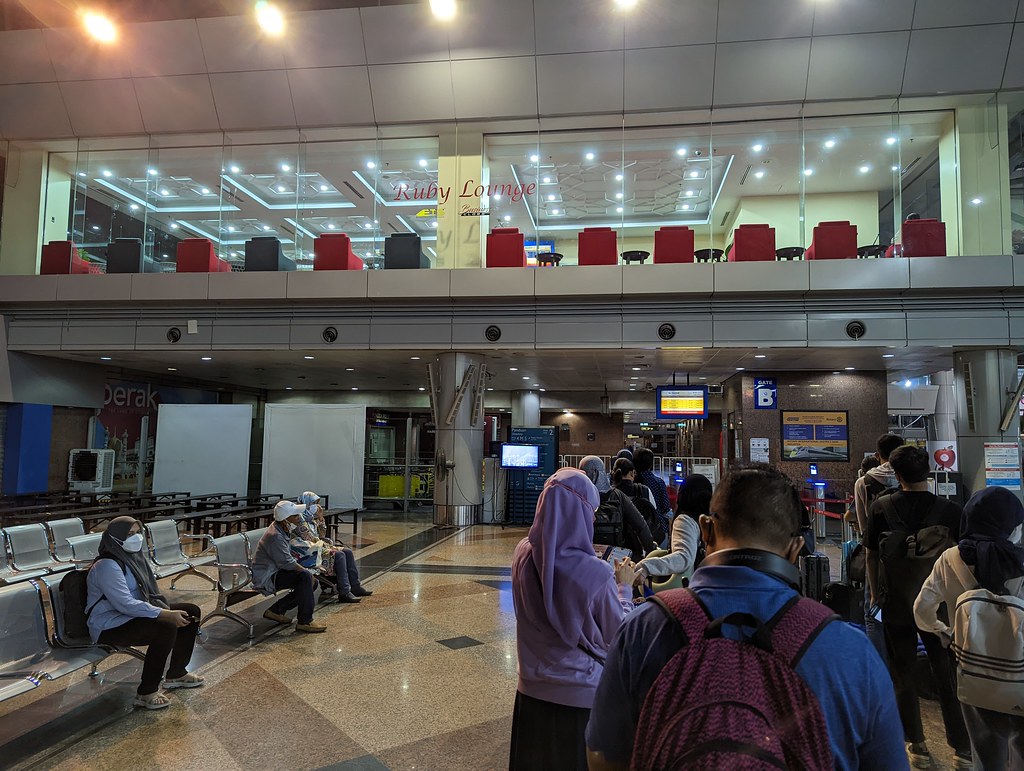
While I am no stranger to Malaysian state railway Keratapi Tanah Melayu (KTM) since I grew up traveling on its trains to visit my Malaysian relatives, it was my first time traveling on its Electric Train Service (ETS). I booked the ticket through KTM’s app two days prior, paying 178 MYR for a Business Class seat to Padang Besar.

Service: KTM ETS Platinum 9272 Coach A Seat 9A
Depart: Kuala Lumpur Sentral 7.08am
Arrive: Padang Besar 12.41pm
Duration: 5h33m
Distance: ~556km
Equipment: KTM Class 93
Cost: 178 MYR (~40 USD)

My first impression was pretty good. My cabin looked clean and the seat seemed comfortable. Like most indoor places in Southeast Asia, the cabin was kept quite cold and I had to bring out an additional layer.


The obligatory seat pitch shot:-

Safety card was found inside the seat pocket.


Each business class seat was also equipped with in-seat entertainment device but there was no content available.

Thankfully there was power outlets where I could charge my devices.

We rolled out of KL Sentral on 7.08am exactly, heading towards northern Peninsular Malaysia.

The train crew soon came around with the meal cart and it was only then when I realised that there was food included.

Chicken bolognese was the only meal choice available; drinks-wise I could choose between tea and coffee.
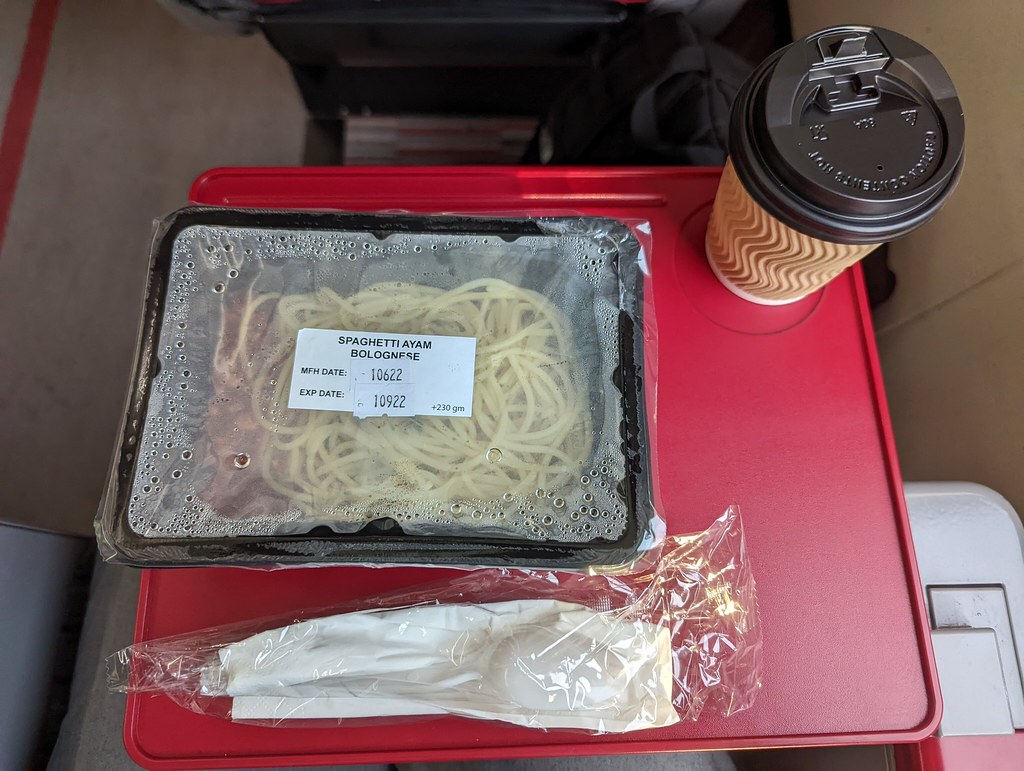
The taste was probably as good as any pre-packaged food could get.

Typical view outside the train:-
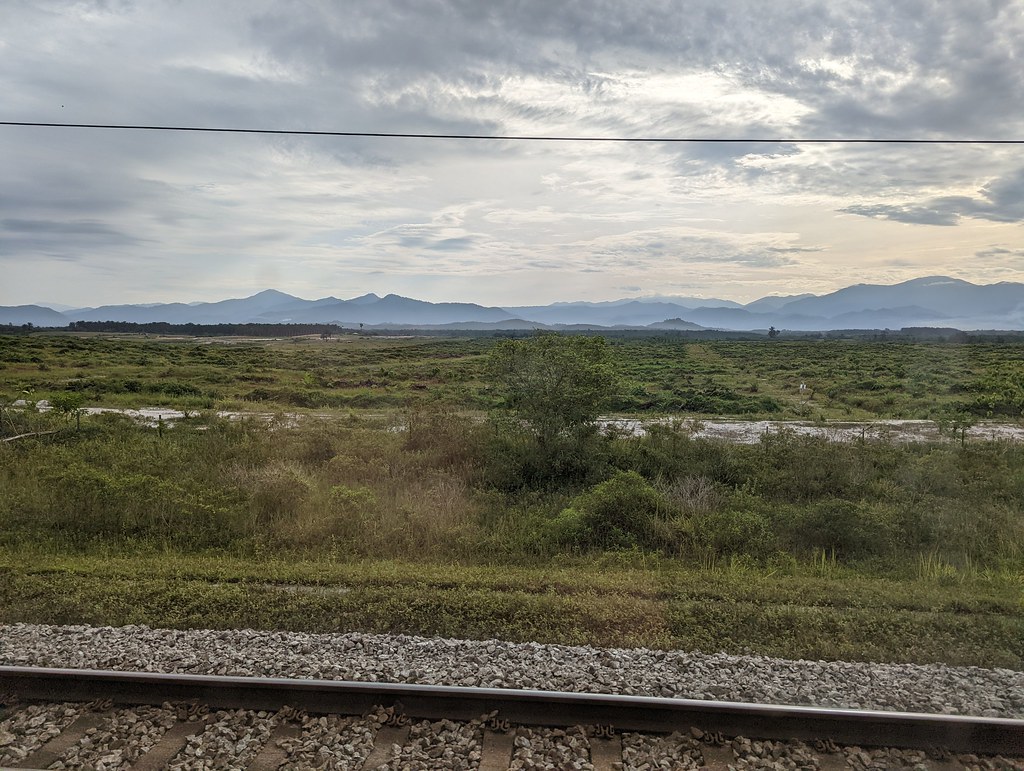
A typical KTM ETS train station:-

The toilet was kept clean throughout.

Another surprise awaited me after the train left Ipoh; the crew cabin around with the second meal service! I was thoroughly impressed.


The train came to a halt outside Taiping. I wasn’t sure what caused the stop.
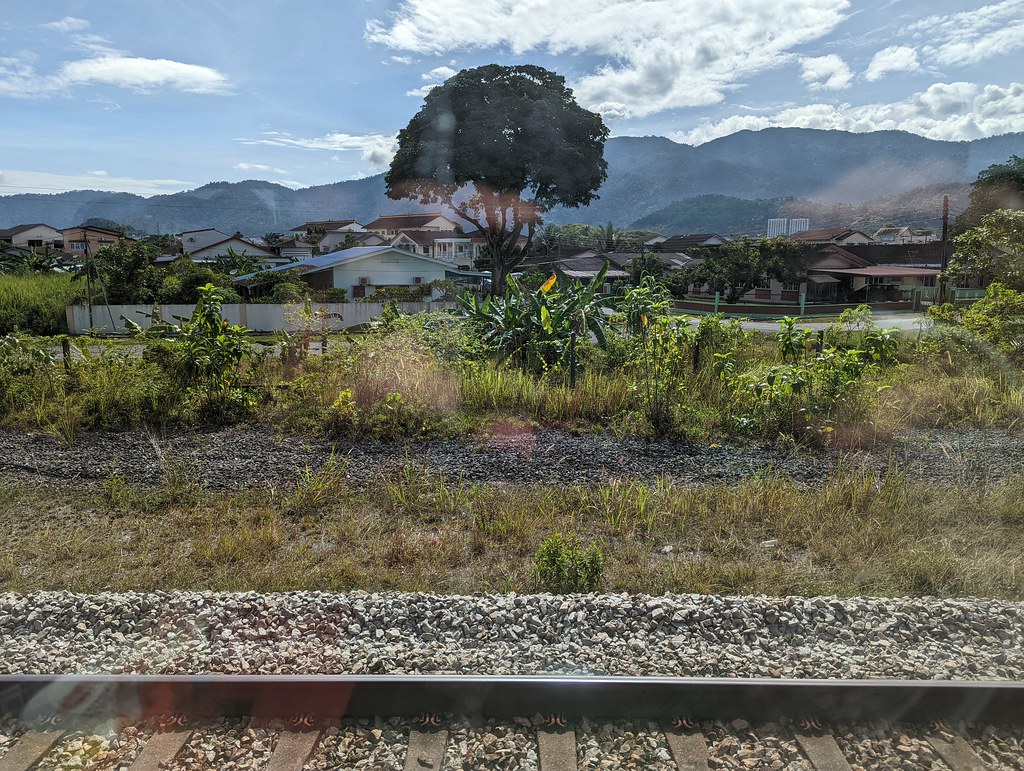
I took a peek of the standard class cabin; it seemed pretty decent too.

The scenery changed from the rubber or oil palm plantations to padi fields when the train entered the state Kedah, also known as the “rice bowl” of Malaysia. The green fields seemed to stretch on forever.

After the penultimate station of Arau, I was the only passenger remaining in my carriage and the crew began to change the direction of the seats for the southbound return journey. We arrived at 12.45pm, just a few minutes behind schedule. I followed the signs on the platform to get out of the station. Passengers were required to scan the QR code on their tickets at the gantries in order to exit into the station.


There used to be two or three daily local Thai trains which connected Padang Besar to Hat Yai but they had been suspended since the start of pandemic in 2020. Hence, one would need to cross the Malaysia-Thai border by foot and then take the minivan to Hat Yai.
One used to be able to use the foot bridge to get across the train tracks to get to the Malaysian Immigration checkpoint at Padang Besar easily. However, the bridge was closed since September 2020 and I was left with no choice but to take an overpriced 20 MYR (4.53 USD) ride in a really old Proton Saga.
At the Malaysian immigration side, I had to get down to get my passport checked and fingerprints scanned.

The driver then drove me across the no man’s land and alighted me just outside of the Thai immigration building. Thailand would be country number 3 for me within the past 24 hours.
In order to enter Thailand, visitors are required to have travel insurance with at least 10,000 USD coverage and apply for Thailand Pass. I have submitted my application a few days prior and it was approved almost immediately.
Before entering the immigration office, I had to fill up the arrival card. Then a Ministry of Health officer would verify my approved Thailand Pass and also stamp on my arrival card. After it was complete, I proceeded to one of the immigration officer’s counters to get my passport and myself stamped into the country.
However, upon seeing my passport, the officer at the counter asked me to go inside a room where another officer began to ask me about my travels. Once he was satisfied with my explanation, he stamped my passport and sent me on my way.

As soon as I walked out of the immigration building, taxi drivers began to offer their transport services which I rejected. On hindsight I should have taken the motorcycle taxi for 5 MYR instead of walking 15 minutes under the hot sun to the minivan station.

As Thailand (GMT+7) is one hour behind Malaysia (GMT+8), I gained one hour crossing the border. I reached the bus station at around 12.45pm and paid 60 THB (1.72 USD) for the minivan ride to Hat Yai.


The minivan departed slightly after 1pm and I got a seat in the last row.

Service: 8301
Depart: Padang Besar Minivan Station ~1.00pm
Arrive: Hat Yai Bus Station ~2.05pm
Duration: 1h5m
Distance: ~50km
Vehicle Model/Registration: Toyota HiAce / 10-6374
Cost: 60 THB (1.72 USD)
While the minivan wasn’t full when leaving Padang Besar, it got filled up with passengers picked up along the way. The 50 km trip took around an hour.

After arriving at Hat Yai bus station, I used Grab to get to Red Planet Hat Yai (68 THB or ~2 USD). The driver could speak fluent Malay and with my limited Malay, we managed to make some small talk over the short 2km ride.

As my next train wouldn’t depart until 5.45pm, I decided to get a room to freshen up before that. While on the train between Kuala Lumpur and Padang Besar, I searched on Agoda and I made a booking at Red Planet Hat Yai, where a single room for the night only cost 12.94 SGD (~9.32 USD).

It was a good decision as the room provided me with a sanctuary from the oppressive southern Thailand hot afternoon.


The room seemed spartan but had all the necessary amenities. I had a good shower and stayed comfortable inside the cool room until it was time to go.


Distance travelled so far: ~ 984km
Segment 1: Singapore to Kuala Lumpur
Segment 2: Kuala Lumpur to Hat Yai
Segment 3: Hat Yai to Bangkok
Segment 4: Ayutthaya to Vientiane
Segment 5: Vientiane to Boten
Segment 6: Boten to Vientiane
Segment 7: Vientiane to Bangkok
Segment 8: Bangkok to Singapore
Epilogue: 10 Random Thoughts from The Trip
Segment 3: Hat Yai to Bangkok
Red Planet Hat Yai is around 500 metres away from Hat Yai Train Station and I arrived there after a short walk to embark on the longest segment of this trip..


Hat Yai is southern Thailand’s largest city but ironically isn’t the capital of its province Songkhla. Its history is intertwined with the development of railway in the region; being the site of the rail transport turned Hat Yai from a small village in 1922 into a major commercial centre now.


Plenty of trains passed through Hat Yai Junction daily and three of them made it all the way to Bangkok. Out of the three, I chose to travel on Special Express CNR 32 which uses the newer carriages built by CRRC.

My train was already at Platform 1 and I didn’t take long to find my carriage (Car 11).

The carriage is an air-conditioned second class sleeper and it consists of 40 bunk beds. The lower bunks are slightly wider than the upper bunks and cost slightly more; I paid 1105 THB (~32 USD) for a lower bunk. Booking through State Railway of Thailand’s dticket app was easy enough.

The crew came around and distribute small bottles of water. It was definitely insufficient for the entire journey to Bangkok and luckily I brought a 1.5 litre of water along for the trip.

Service: State Railway of Thailand Special Express CNR 32 Aircon Sleeper 2nd Class Car 12 Seat 21
Depart: Hat Yai Junction 5.45pm
Arrive: Bangkok Hua Lamphong 11.30am (+1)
Duration: 17h45m
Distance: ~936km
Cost: 1105 THB (~32 USD)
I noticed that there were three different types of train crew: the first type were in khaki uniform with peak caps and their only job seemed to be checking tickets. The second type of crew were in white shirt and black pants and they were in charge of converting the seats into beds. The third set of crew were wearing blue uniform and they were the ones doing all the cleaning.
The train departed Hat Yai on time at 5.45pm and we rolled north towards Bangkok as the sun was setting in the horizon. The first set of crew came around and checked for the tickets and directed my seat mate to the correct one.

The second set crew came around after that and began to convert the seats into beds. They were really fast and probably took less than two minutes for each bed.
Each bunk was equipped with a reading light and a plug. I could charge all my items during my long journey north.

Despite the on-time departure, we reached the next stop Phatthalung 10 minutes late. I believed that it was possible to purchase dinner from the crew but I didn’t understand enough Thai to get any.
I fall asleep easily to the rocking motion of the carriage but did wake up in the middle of the night to use the bathroom.

Each carriage had several screens which displayed the trip information. I learnt that the carriage temperature was kept at the chilly 21 degrees Celsius.

I woke up to the green Thai countryside. We were already behind schedule, arriving in Hua Hin 1.5 hour late.


Train crew were going around asking if anyone wanted to place order for breakfast at around 7am. I ordered chicken fried rice for 60 THB and it was delivered after Petchaburi at 8.45am.

After breakfast, I laid in my bunk until 11.30am when the staff forced me off and converted it back to seats. While we should have arrived based on the schedule, we were still more than an hour away from the destination.
While passing by the penultimate station Bang Sue Junction, the new Bang Sue Grand station came into view. The biggest train station in Southeast Asia, it will replace the ageing Hua Lamphong station as well as to be the terminus of the high-speed rail line from Lao border in the future.
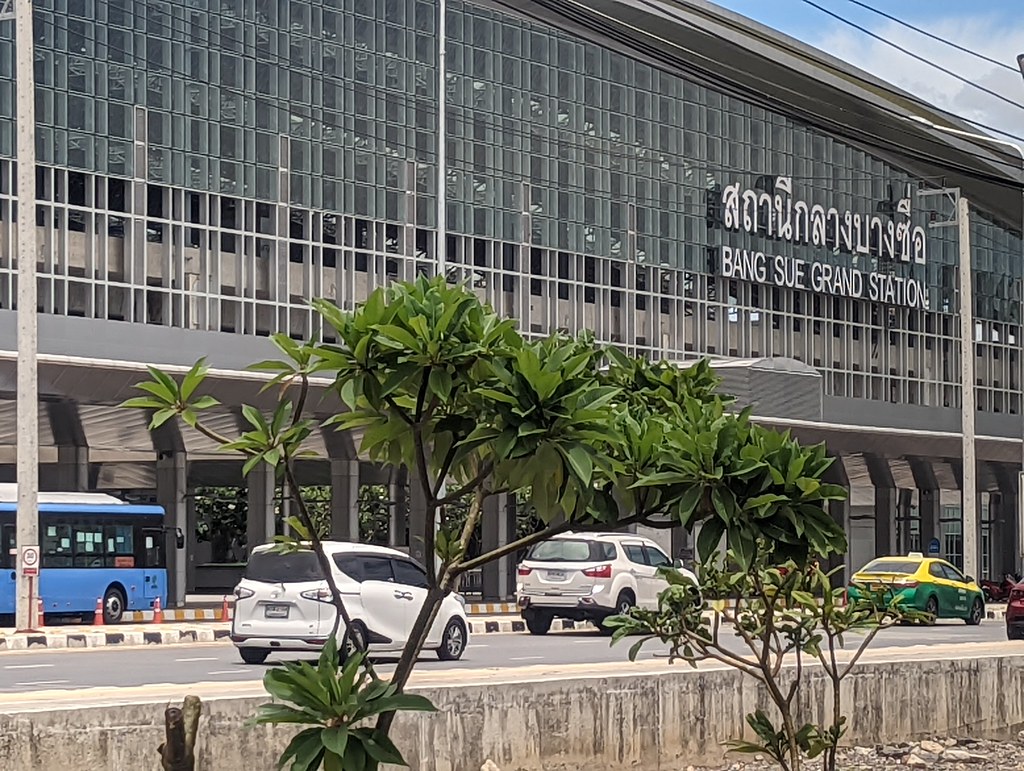
The last stretch between Bang Sue and Hua Lamphong was through a very dense residential area and their laundry was definitely within my reach.
We finally arrived at 12.55pm after 19 hours of travel. While the train ride had been comfortable, it was nice to be back on firm ground again.

The staff were all busy unloading the used bedsheets for laundry.

Hitachi 8FA-36C (no. 4511) was the diesel locomotive which pulled us into Bangkok.


The portrait of King Rama V Chulalongkorn welcomed the passengers into Bangkok Station. The current King Rama X Vajiralongkorn is his great-grandson.

My day of arrival coincided with the birthday of the current Queen and there were signs on the exterior of the station.


Instead of continuing onwards towards Laos, I opted to spend a night in Bangkok. My hotel for the night was IR-ON Hotel, booked two nights before for 43.28 SGD (~31 USD). A combination of MRT and BTS and a short walk from Thong Lo BTS station brought me to this pretty unique property.
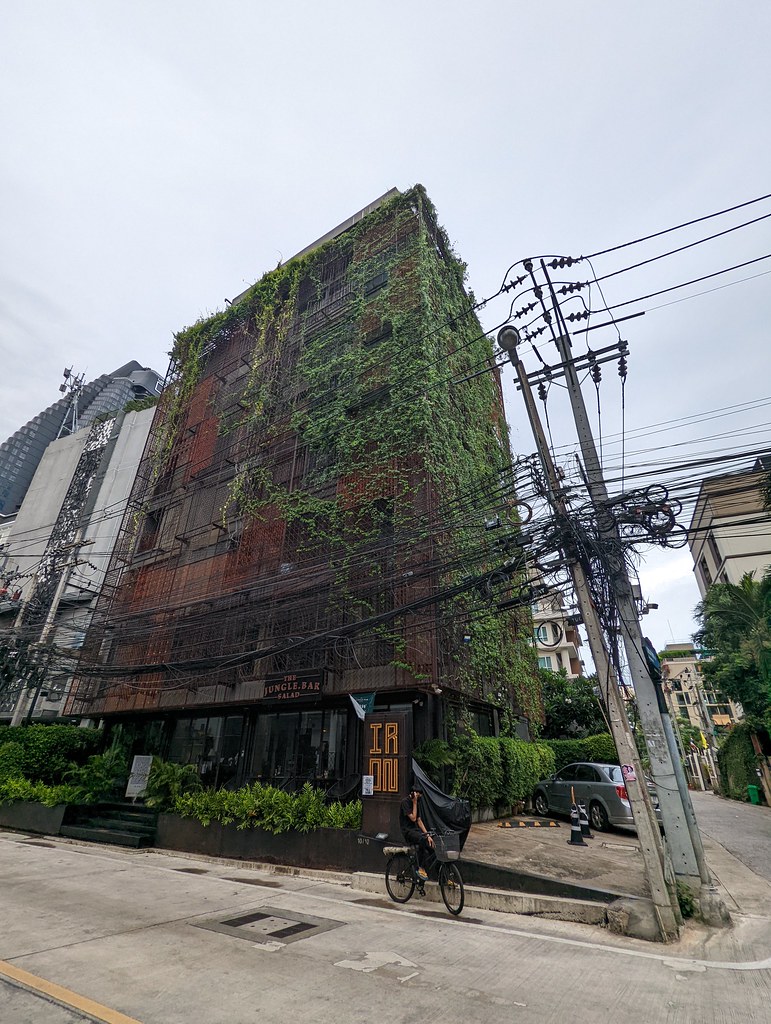
My room had plenty of character too.


I had a friend who’s living in Bangkok and we got to hang out together. He and his wife brought me to a few places, including Hua Mum Night Market.

One of the top attractions of this night market is the restaurant with topless hunks in aprons dancing.

Our dinner was seafood in a bucket.


We ordered the large portion and it was a pretty satisfying meal.

Distance travelled so far: ~ 1,920km
Segment 4: Ayutthaya to Vientiane
The next day, my friend and his wife planned a day trip to Ayutthaya and I got to tag along. Although I had been to Thailand quite a number of times, it’s my first time visiting it too.
Depart: Bangkok 9.30am
Arrive: Ayutthaya 10.45am
Duration: ~1h15m
Distance: ~85km
Cost: Free:)
Ayutthaya was the former capital of the Ayutthaya Kingdom which existed between 14th and 18th century. It was destroyed by the Burmese invaders in 1767 and the centre of power has since shifted to Bangkok, which remains the capital of the Thai state until now.
Our first stop was Wat Chaiwatthanaram, located just outside the UNESCO heritage site of Ayutthaya Historic City. The visitors were mostly Thai tourists who rented traditional attire from the nearby shops for photo-taking.



While the sky seemed cloudy, the temperature was quite high and decided to cool off with some drinks at the cafe of the insta-friendly Sala Ayutthaya.

The curved walls are popular with Instagrammers.


Lunch was at a nearby Thai restaurant where we ordered some of the local favourites.
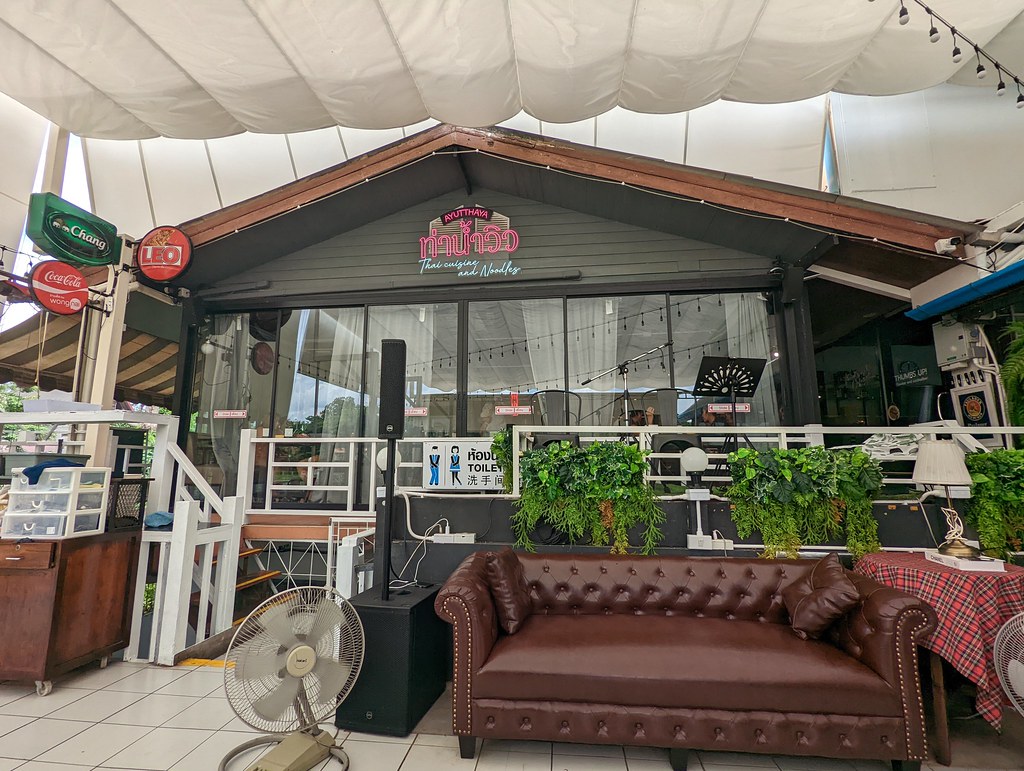

Ayutthaya is famous for river prawns.

We resumed the temple-hopping after lunch – this should be Wat Mahatat.

This should be Wat Ratchaburana.

We took a break from the historic ruins and visited the working temple of Wihan Phra Mongkhon Bophit. It is famous for the massive glided status of sitting Buddha.

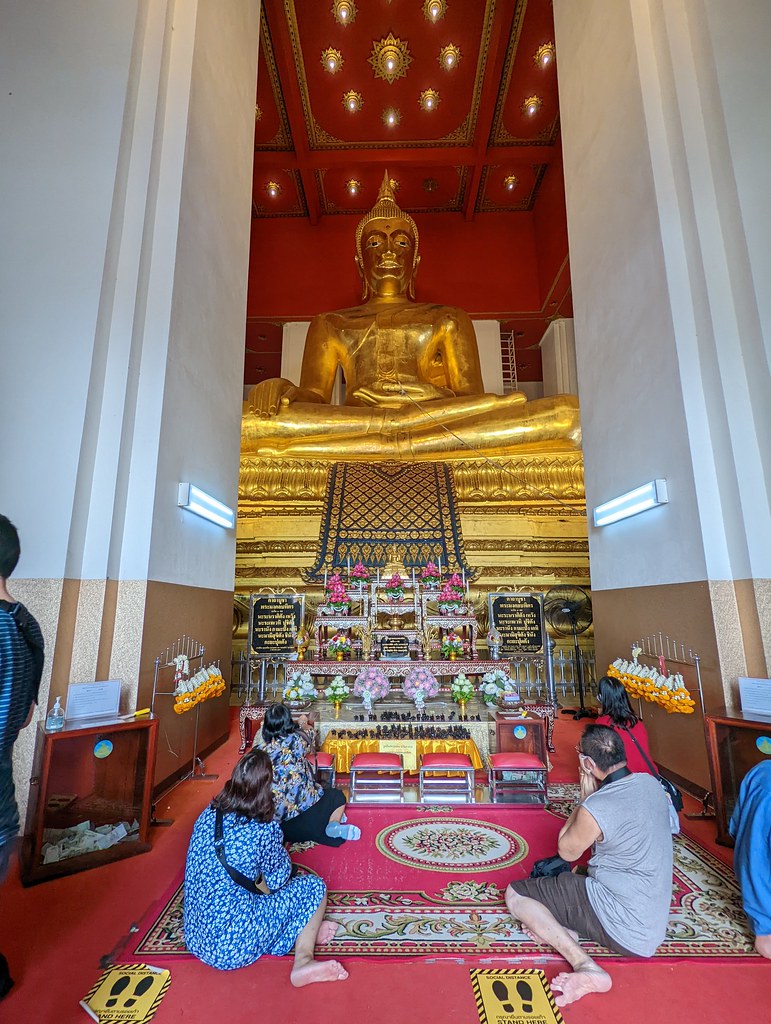

By this time, the ruins all looked the same to me and we reckoned that it wasn’t a bad idea to cool off with some desserts at a cafe.


We only got back out on the streets when the night market was about to open.

This particular stall got our attention and the queue was enough to attract my friend’s wife to buy some fried fish cakes from them.


My friend picked out a local restaurant for dinner and we had some authentic Thai food. The dishes were mostly good and we totally forgot to take any pictures of the food.

After dinner, my friend dropped me off at Ayutthaya Station well ahead of time.

All north-bound and northeast-bound SRT trains passed through here and I didn’t need to backtrack to Bangkok to continue my journey to the Thai border town of Nong Khai.

Looking south for trains coming from Bangkok.

I realised that we did cover quite a bit of the city during our day there.

In the direction of Chiang Mai / Nong Khai / Ubon Ratchatani:-

I was reminded everywhere about Queen’s birthday.

Beside passenger traffic, State Railway of Thailand also transport cargo. For those who don’t want to ride their motorcycles all the way to their destinations, the trains provide a good alternative.

Service: State Railway of Thailand Special Express CNR 25 Aircon Sleeper 2nd Class Car 2 Seat 10
Depart: Ayutthaya 9.40pm
Arrive: Nong Khai 6.25am
Duration: 8h45m
Distance: ~550km
Cost: 972 THB (~28 USD)
The train arrived at Ayutthaya at 9.42pm and my carriage was quite full. My bunk was already converted into bed mode.

I made myself comfortable after the crew came to verify my train ticket on the dticket app.

It appeared that we might be a bit late arriving into Nong Khai.

I slept through the night and woke up when we were reaching Udon Thani. The crew soon went around to convert the beds back to seats.

Is this construction for the new high-speed rail to Bangkok?

It seemed that the earliest that the high-speed train service be in operation will be 2028 onwards, connecting Thailand to China’s train network via Laos. While the travel time between Bangkok and Nong Khai could be as fast as within three hours (based on top speed of 250 km/h), I hope that overnight trains will continue to run.
We arrived at Nong Khai station just 10 minutes after the scheduled arrival time of 6.25am. There used to be a daily train which connected Nong Khai to Thanaleng across the Mekong in Laos but like the other cross-border train service between Padang Besar and Hat Yai, it was suspended due to COVID-19.

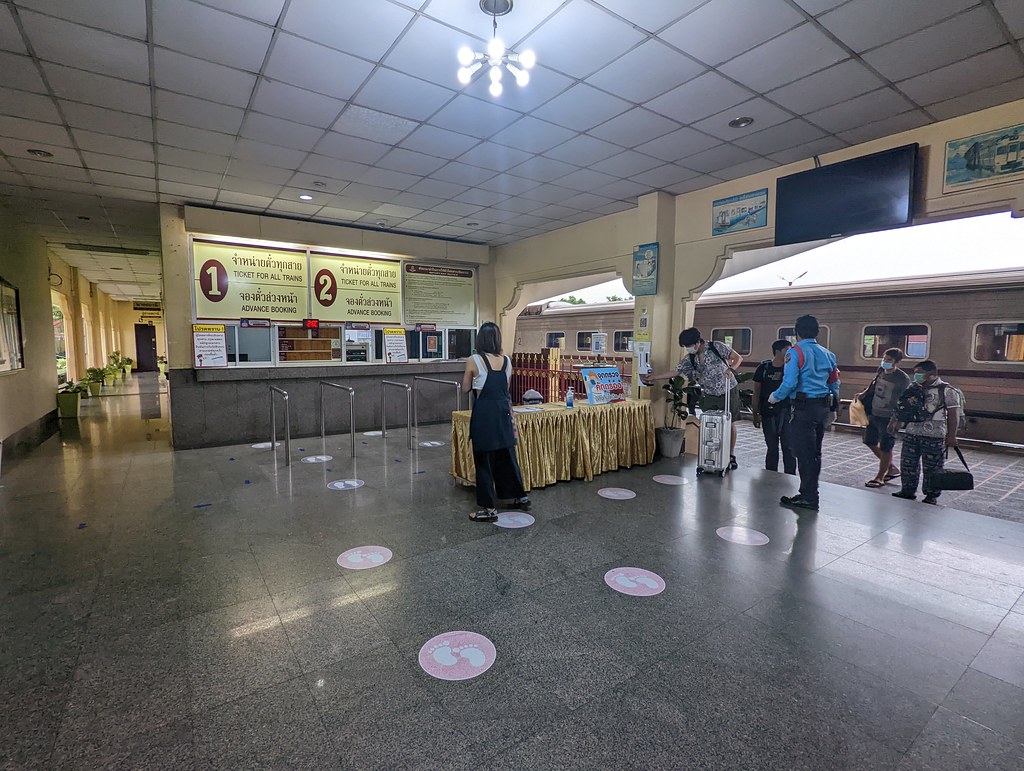
Outside of the station, plenty of tuktuk drivers were offering shared rides to the Thai-Lao Friendship Bridge; I was charged 50 THB (~1.43 USD) for the short 2km ride.


Beside the train passengers, there was a big group of Thai cyclists whose idea of fun was to cycle to another country on a drizzly Sunday morning.

I managed to get stamped out from Thailand by 6.50am and bought the shuttle bus ticket (30 THB + extra 5 THB for out-of-office hours) from the counter.

The shuttle bus was an old Thailand-registered bus and it would take five minutes to cross the Mekong River which separates Thailand from Laos. While on the bridge, the bus would drive on the left as in Thailand and only cross over to the other side when it was approaching the Lao immigration building.
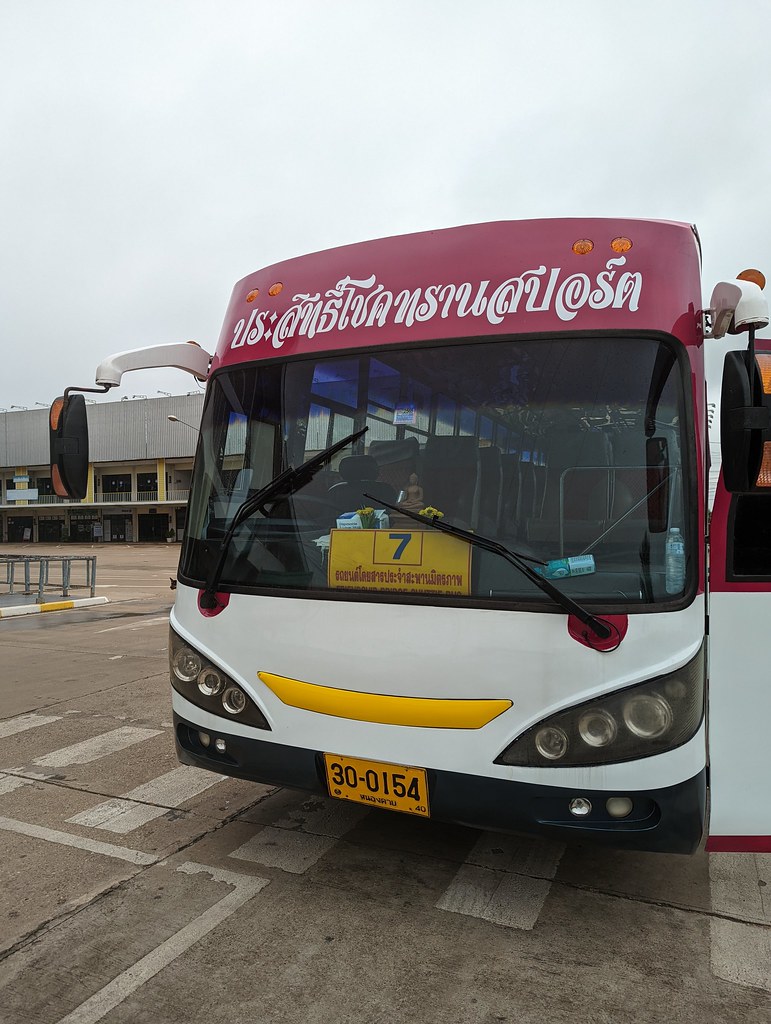

On the fifth day, I entered Laos, my fourth and final country of the trip.
I was among the first to fill up the arrival form and was done with Lao immigration by 7.20am. The only snag that I encountered was the lack of physical copy for my vaccination certificate; the immigration officer eventually stamped me in after looking at the PDF copy on my phone and just reminded me to print it out the next time.

There were several moneychangers and tuktuk drivers offering their services and even though I rejected their offers, they were friendly enough to point me to where the bus stop was (roughly 1 o’clock direction).
The local bus 14 operated by Vientiane City 2 Bus Service was already waiting at the bus stop then. It would travel from Thai-Lao Friendship Bridge to Vientiane’s Central Bus Station, a place which I would become familiar with over the next few days.
It was nice to get the newer BYD C8 electric bus. The bus conductor would come around to collect the 10,000 LAK (~0.70 USD) fare. As I didn’t have any Lao Kip with me yet, she accepted my 100 THB note, and gave me 25,000 LAK change. Based on the official THB:LAK exchange rate then, my fare worked out to be 15,000 LAK.

One of the things that we noticed on the ~20km ride was that there were long queues outside petrol stations. I would later learn that Laos was facing a big crisis with plummeting exchange rates and fuel shortages, causing extraordinary hardship for ordinary Lao citizens.

After around 30 minutes, the bus arrived at Vientiane’s Central Bus Station and it meant that I needed to start thinking hard about my next few days in Laos.

Distance travelled so far: ~ 2,579km
Segment 5: Vientiane to Boten
Since it was too early to check in, I decided to search on Google maps for a breakfast place and it led me to Phở & Bún Chả Hà Nội, a Vietnamese restaurant a block away from Central Bus Station.

I ordered a small bowl of beef pho for 20,000 LAK and it was delicious.

The cuter of the two dogs which kept me company while I was there.

Next up was to settle the money issue. I was debating between withdrawing from ATM or exchanging USD at a moneychanger; in the end decided to go for the latter. It turned out to be a better decision because the moneychanger was offering 17,200 LAK for 1 USD as opposed to the official exchange rate of around 14,000 LAK for 1 USD. It meant that the locals don’t have any confidence in the outlook of Lao Kip and are willing to pay higher than market rate to purchase hard currency such as USD in order to preserve their wealth.

Finally 10am rolled around and I headed to Vientiane Centre Lao to purchase the train tickets.
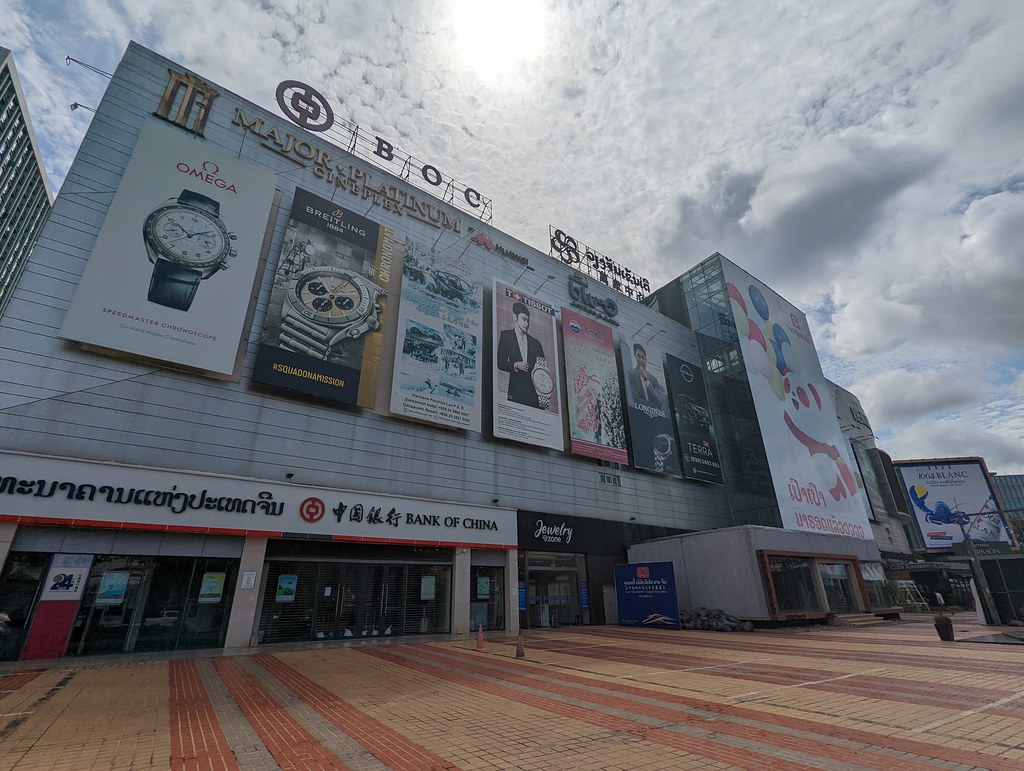
Lao-China Railway started its operation on 3 December 2021, linking Vientiane with Boten at Lao border with China (and onwards to Kunming). In the initial stage, passengers could only purchase tickets at the stations and it was only in February 2022 when a ticket office opened in downtown Vientiane.

However, the downtown office doesn’t accept any cash and only allow transfers through the local bank BCEL OnePay app. The booking system is also very restrictive; I could only buy tickets originating in Vientiane but not from other cities. Passengers could only buy tickets for the next three days and not beyond that. There was also an additional 20,000 LAK admin fee per ticket.

Despite having no BCEL OnePay app, I still queued up in the hope that I could secure a ticket. The lady at the counter could speak Lao and Mandarin and she told me that while there was ticket available for the following day’s train, she wasn’t able to accept cash. Most of the people in the queue in front of me were foreigners as well and had the same problem.

I approached locals who were purchasing tickets for themselves to help but they didn’t have sufficient balance in the account.
Eventually the kind Chinese owner of a nearby shop assisted and even declined my offer to pay her extra for the trouble. Otherwise I would need to go to the train station to buy the ticket with cash.

There seemed to be an event going on outside Vientiane Center Lao in the evening; the area should be pretty nice after sunset.


Adjacent to Vientiane Center Lao was another shopping mall Parkson Laos. I reckon that it’s probably the most fancy mall in the entire country.

After getting some foodstuff from the supermarket inside the mall, I took a tuktuk to One Vientiane Hotel for 30,000 LAK. The driver wasn’t willing to go lower despite the relatively short distance of 2km.

Although it was before noon, the friendly staff still let me check in. I had booked the room two nights ago on Agoda, paying 48.53 SGD (~35 USD) for a night.

I got a nice big room with a King bed.

If there was a real complaint, it had to be the placement of the plugs. They were all under the table.


As I woke up really early on the train, I showered and rested until I felt hungry enough to go out for lunch.
Wat Inpeng was the nearest landmark to the hotel.

Lunch was fish and chips with Beer Lao at Sticky Fingers. The cost was a very reasonable 75,000 LAK (~4.30 USD).

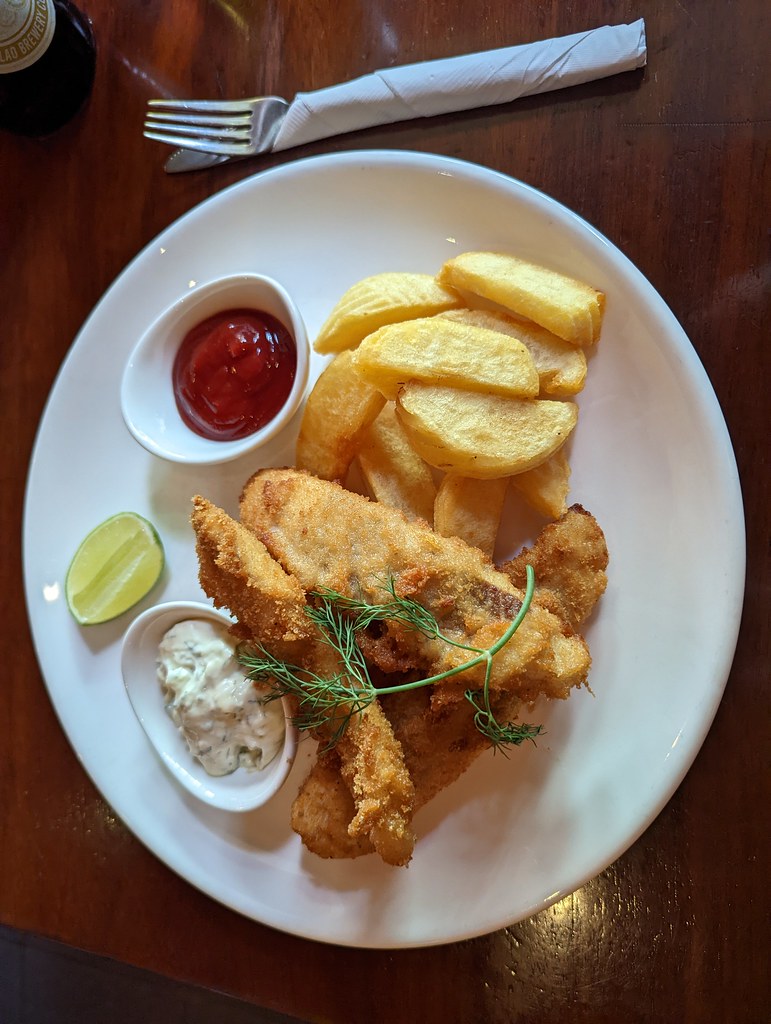
On the way back, I walked past Wat Ong Teu. That would be all of my sightseeing that afternoon.

I did more thinking when I got back and decided that the easiest option for me was to do a day trip from Vientiane to Boten the next day. Hence, I extended one more night at the hotel and paid 400,000 LAK (~23 USD) directly.
I ventured out again in the evening and headed in the direction of the night market. While it didn’t seem much at first, I was impressed with its size and scale after wondering around.

There were a lot of stalls, selling both food and merchandise.



There was an amusement park for kids by the river and it seemed that the locals were all out having fun on a Sunday evening.


There were also several open-air restaurants by the river and they seemed popular.

One of the things that I couldn’t accept or understand was the presence of begpackers. The sense of self-entitlement was beyond belief.
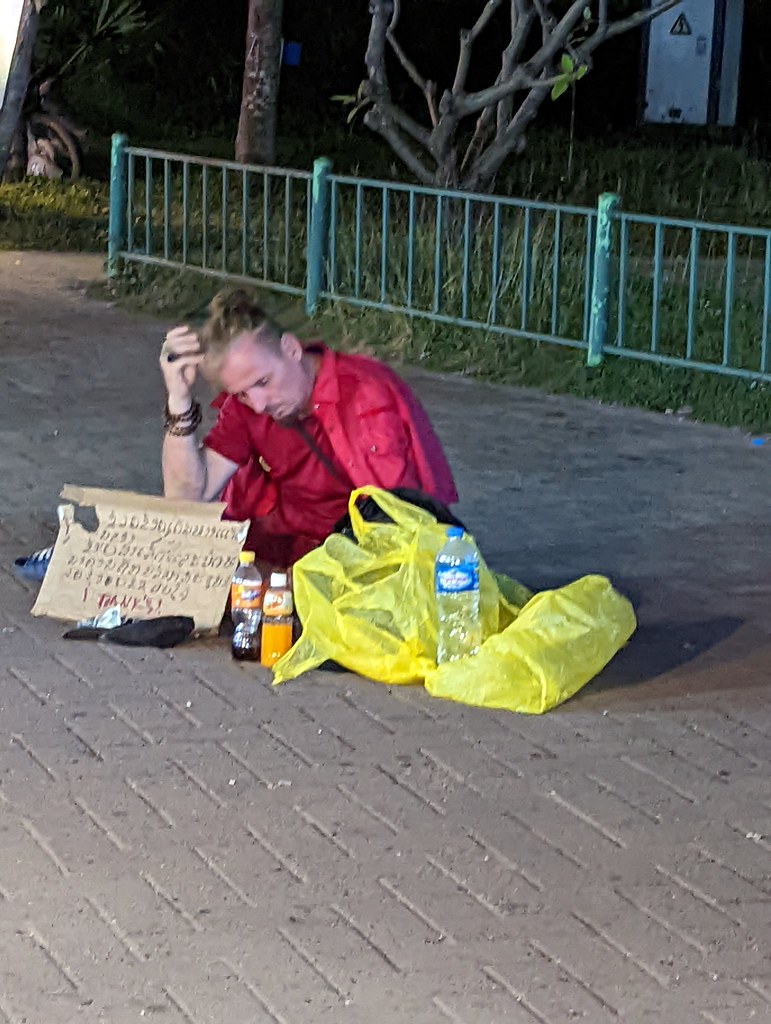
Reckoning that my stomach might not be up for the street food, my dinner was fried kweytiau and watermelon smoothie at Papao (50,000 LAK or ~2.90 USD) before I retired for the night.

It was another day of early start and I left the hotel at 6am to walk to Central Bus Station. I had seen the public bus schedule the day before; bus 28 to the train station would depart at 6.30am.
While walking past the Presidential Palace, I could see Patuxai in the far horizon.

I arrived at the station around 10 minutes before departure time. The bus taking us to the railway station was an older Isuzu model. It used to be a city bus in Kyoto and was donated to Vientiane after its retirement in Japan. The fare was 15,000 LAK (~0.87 USD)

There were two things that I didn’t like about the bus – firstly, there were a lot of mosquitos inside and secondly, its window film was so opaque that it was impossible to take any photographs out of the windows.
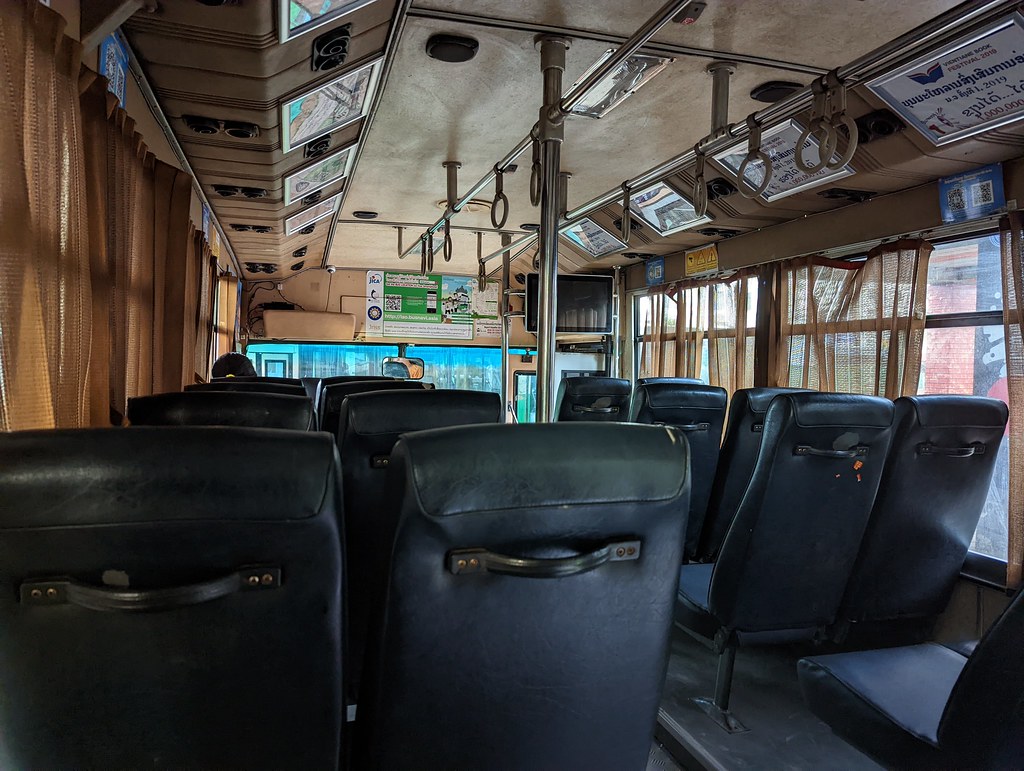
Vientiane Station is 15km away from downtown and the bus arrived there half an hour later as per scheduled. My first thought was: was I in China now?

There was a long queue to buy tickets by then. I wasn’t sure if they were looking to travel on the same day.

The entire project was constructed and operated by China Railways and thus the service followed Chinese SOP entirely. There was a first queue which checked for tickets and a second queue to go through the security. There is only one entrance with two X-ray machines, creating a bottleneck every time when there’s a departure. I cannot imagine the situation if either of these machines break down.
The waiting hall wouldn’t look out of place in a third-tier Chinese city.

There was no food and drinks inside the waiting hall beside a vending machine which doesn’t give back any change. There were vendors selling local food outside the station so travellers would be better off getting food before entering.

Third and final queue was the ticket check before entering the platform. The train north would be quite full on this Monday morning.

As of June 2022, there are two trains between Vientiane and Boten daily. The faster C82 departs at 7.50am and takes 3h35m while the slower K12 departs at 9am and takes 5h20m. There is an afternoon fast train C84 departing Vientiane at 4.05pm but it goes to only until Luang Prabang.

Service: Lao China Railway C82 Car 1 Seat 14A
Depart: Vientiane 7.50am
Arrive: Boten 11.25am
Duration: 3h35m
Distance: ~406km
Equipment: CR200J
Cost: 430,000 LAK (~25 USD)
I found myself transported to “China” again when I boarded the carriage. The CR200J trains could travel at the top speed of 160km/h, cutting the travel time from more than 12 hours by road to merely 3.5 hours.

The seat pitch was more than decent and I was happy to get the window seat.

Train C82 departed on time at 7.50am sharp. While traveling northwards, rows 1 to 10 will be facing the direction of travel and rows 11 to 20 are facing the opposite.
The female attendant could speak both Lao and Mandarin Chinese and she went around checking tickets soon after departure. She would also strictly enforce that the passengers sit in their assigned seats.
The terrain was pretty flat getting out of Vientiane and I noticed that the railway was running adjacent to the new expressway between Vientiane and Vang Vieng for some distance.
An hour later, we arrived into the first stop Vang Vieng. The station staff would stand at attention when the train rolled in and out of the station.

From the train, Vang Vieng did look like a good place to chill for a couple of days.

The terrain got more hilly as we headed northwards from Vang Vieng.

We actually spent more time inside tunnels than out of it once we were north of Vang Vieng but the scenery was fantastic whenever we were out of it.

There was no food for sale on the train but the crew did go around selling bottled water for 12,000 LAK (~0.70 USD) each.
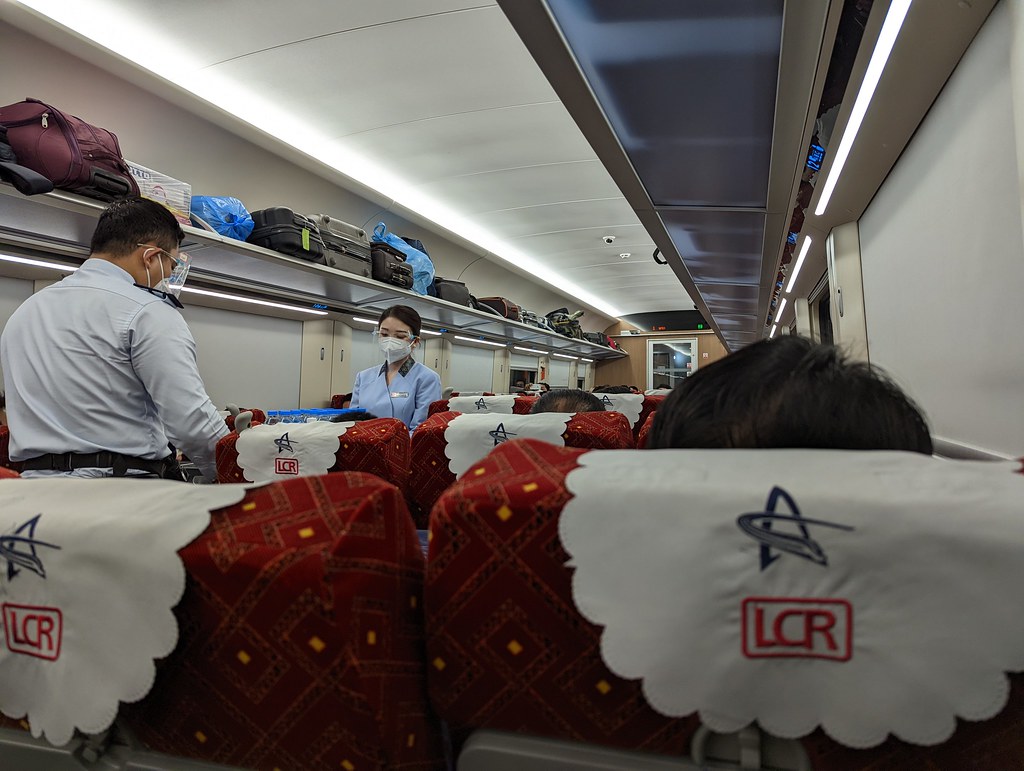
The next stop was the royal city of Luang Prabang at around 9.40am. We would travel across Nam Khan River just prior to arriving there.

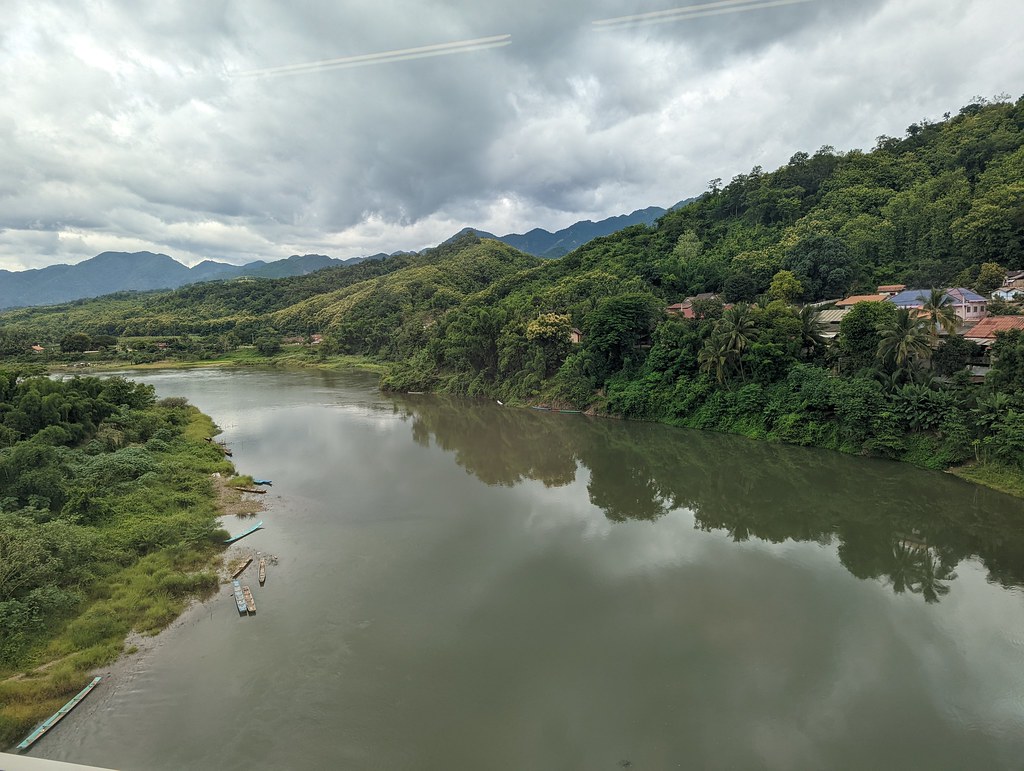
I noticed that the train was usually slightly early arriving at the stations. Beside passengers, the railway was constructed to also carry freight which are mostly manufactured goods from China.

More than half of the passengers in my carriage were disembarking in Luang Prabang and they were replaced by new passengers traveling north.
After leaving Luang Prabang, we went across Nam Khan river again.

The next stop was Muang Xai, around an hour away. At the station, I noticed that the brick was imprinted with the Lao-China Railway logo – Chinese characters representing Laos and China.

Another thing that I noticed was that the English on the train’s scrolling text screen was just direct translation from Chinese. For instance, the Chinese version was 孟赛站到了 and the English one would be Muang Xay Station is arrived.
There were some projects while on the way to Nateuy and they should be Chinese-funded investments. Couldn’t help but wonder how Laos could pay off all these debts in the future.


Towards the end of the journey I went to check out the bathroom. There were more squat toilets than seat toilets, which was probably in line with the locals’ preference.


It was only short 12 minutes ride to from Nateuy to Boten station and from what I could see, it’s a big logistics hub for Lao-China trade and there were many Chinese in Boten. I also overheard a phone call where a Chinese guy was asking his friend to fetch him from the train station. However, his friend said that he wasn’t able to because his vehicle had ran out of fuel due to the ongoing crisis.
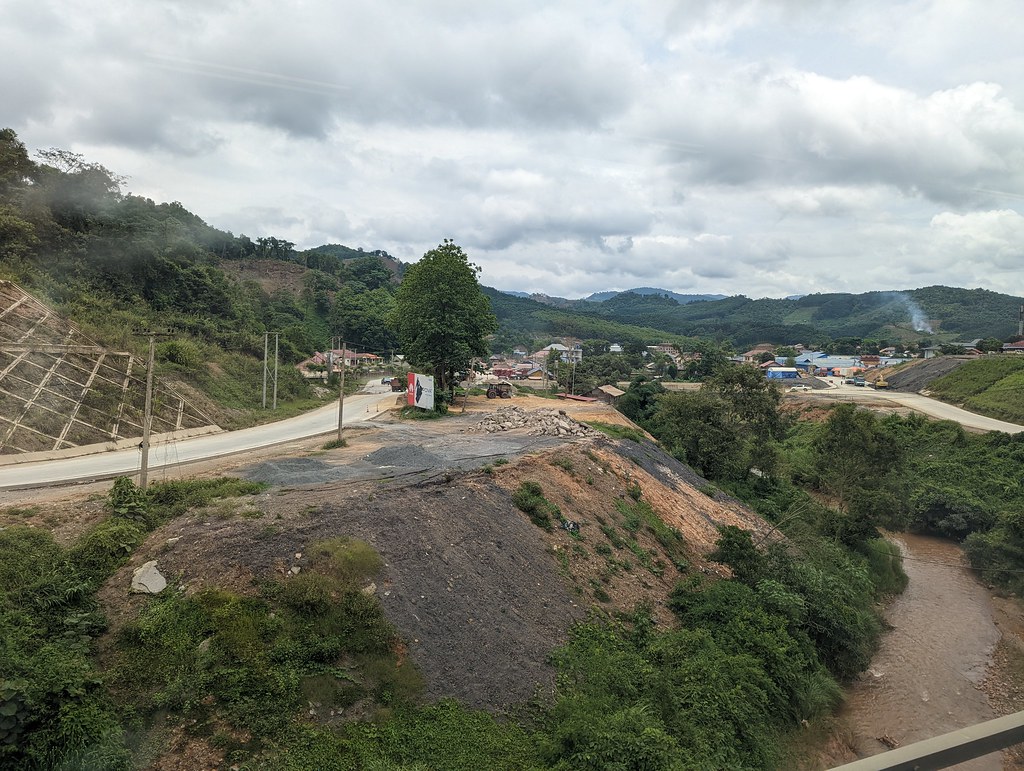

Arrival was on time and I followed the crowd out of the station.

And here I was, just five kilometres away from China.
I could probably get a little closer but James from Nomadic Notes was in the area a week earlier and he shared that people entering Boten are required to have negative PCR test result. He was nice enough to reply my questions on Lao-China Railways in DM too.

Complete.

After six days and almost 3,000 km on the road, I would turn around from here and start my journey home.
Distance travelled so far: ~2,985km
Segment 6: Boten to Vientiane
As of June 2022, there are two daily trains from Boten to Vientiane. The faster express train C81 departs at 11.55am and takes 3h35m while the slower normal train K11 departs at 4.40pm and takes 5h15m.
As soon as I exited Boten station, I just turned around and checked out the ticket counter.

There was one person ahead of me and while waiting, I studied the board displaying availability.

It seemed that there was availability on the imminent C81. I first tried asking in English but the counter staff couldn’t understand me at all. Thankfully he knew Mandarin Chinese and confirmed that there were still seats for sale.
Not wanting to wait five hours in Boten and then arriving late in Vientiane on Train K11, I bought the last second class ticket on C81 for 407,000 LAK (~23.60 USD). There were still four first class tickets available (645,000 LAK or ~37.50 USD) but I couldn’t afford it due to my lack of Lao Kip.
Most of the people hanging outside the station were Chinese. Boten town itself had a pretty storied history in the last two decades and was probably worth a real visit next time.

So after a brief 10 minute stay outside of Boten station, I found myself back inside after a quick security check. Boten is a smaller station compared to Vientiane and only has one X-ray machine for domestic departure.

The domestic departure hall was on the south side of the building and smaller than the adjacent international departure hall. I saw some people sitting inside the international departure side but it was unlikely that there was any train to China at the moment.

Service: Lao China Railway C81 Car 7 Seat 10F
Depart: Boten 11.55am
Arrive: Vientiane 3.30pm
Duration: 3h35m
Distance: ~406km
Equipment: CR200J
Cost: 407,000 LAK (~23.60 USD)
The train was the same one who brought me from Vientiane but I still discovered something new on the return trip: there were plugs and USB charging points underneath the seats.

The train departed on-time and I was the only passenger in car 7 then. It was only at Nateuy where more passengers boarded.

I also used the washroom and it ran out of toilet paper for this return journey.
Crossing Mekong, the mother river of Indochina. Originating from the Tibetan plateau, it flows through China, Myanmar, Laos, Thailand, Cambodia before emptying into South China Sea in southern Vietnam.

Luang Prabang station was the busiest station, which explained the 8-minute stop in schedule.

While not in tunnels, I would just admire the hills.

The clouds were really low and it felt misty outside.
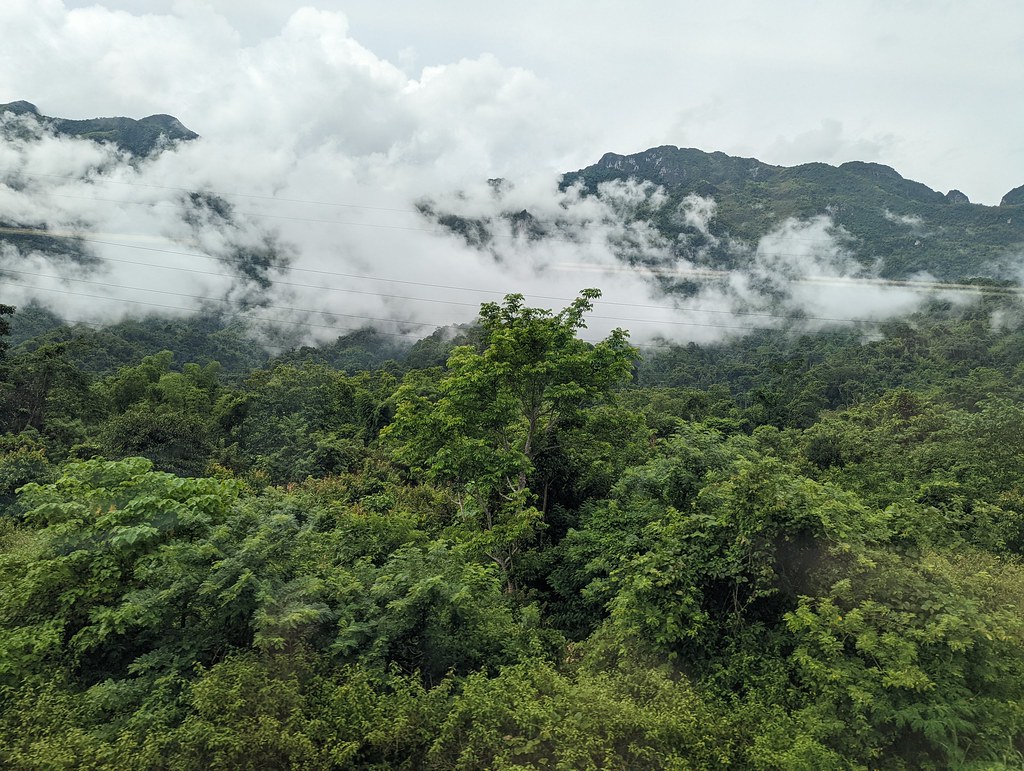
From Vang Vieng, it would be just another hour to Vientiane.

Passing by a fair bit of agricultural land near Vientiane. Some of the issues facing Lao farmers these days were the lack of fuel to operate machinery and increase in the price of fertilisers. There are legitimate concerns of food shortages when the harvest season comes around.

The train arrived on time at Vientiane station platform two and we had to use the underpass to exit the station. One had to show his/her train ticket in order to exit the station and I spotted some guy attempting to bypass the check by pretending not to notice the railway staff.
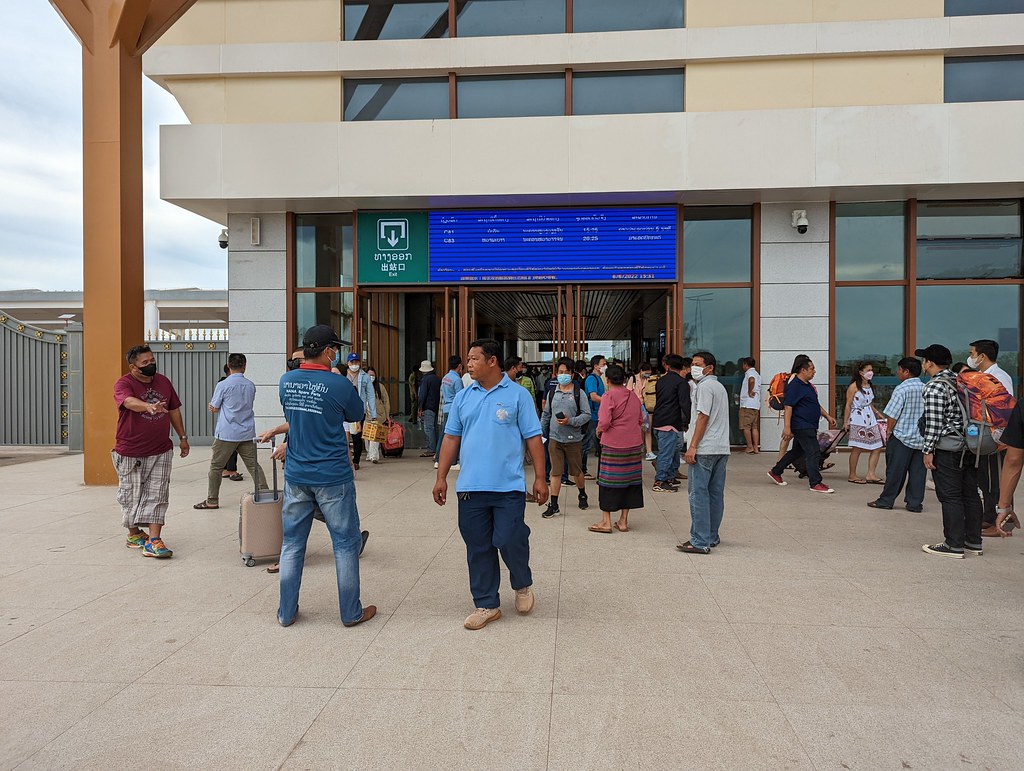
As soon as I exited the station, public buses heading to Central Bus Station as well as Friendship Bridge (for Nong Khai, Thailand) were already waiting outside for arriving passengers. It was definitely possible for travellers arriving on C81 to cross the border to make the 6.50pm train to Bangkok from Nong Khai.

Bus 28 was scheduled to depart 15 minutes after the arrival of C81 and my seat mate had sufficient time to grab some late lunch from the vendors outside the station.

The late afternoon traffic was way heavier compared to the morning one. Along the way, the bus made a stop at the Southern Bus Terminal (for buses heading to Southern Laos) as well as at Patuxai. In all, it took one hour to reach downtown Vientiane, twice the time taken in the morning.

I retraced my steps back to my hotel, stopping by for a while at Wat Si Saket. It seemed to be closed already though.


Another picture of Patuxai from afar.

At the end of my 20 minute walk was a Chinese restaurant called Liaoning Dumpling Restaurant. I had been thinking about dinner and thought that while I couldn’t enter China earlier, I could have Chinese food instead.
Beerlao was cheaper than Tsingtao though so not everything’s Chinese.

One of the disadvantages of knowing Mandarin Chinese was that I could understand the content that the restaurant boss was listening to on his phone. Some monotonous guy was narrating about the biology labs discovered in Ukraine proved that USA created COVID-19 but these fascist Ukrainians and evil Americans would soon be defeated by Putin.


While I didn’t quite enjoy the restaurant boss’s choice of content, the food was another matter altogether. I was probably quite hungry too and I totally cleaned the fried rice and steamed pork dumplings out. Total damage was a very reasonable 83,000 LAK (~4.80 USD) and I returned to the hotel satisfied.
Distance travelled so far: ~3,391km
Segment 7: Vientiane to Bangkok
My train to Bangkok wouldn’t depart from Nong Khai until the evening and it meant that I would have a relaxing day in Vientiane.
After checking out from One Vientiane Hotel, I walked towards where the restaurants were. Noticed along the way that a new Chinese-invested Doubletree Hilton would open in Vientiane soon.

I decided to while away some time first at Joma Bakery. It could be considered as an institution for tourists to Laos, providing western coffee and baked goods to travellers since 1996.


I had a slice of carrot cake as well as a glass of lemonade to go with it (50,000 LAK or ~2.90 USD).


After I was done with the desserts, it was time for a change of scenery. I continued to walk in the direction of the bus station and spotted these signs.

The second place that I stopped by was Dada Cafe.

Lunch was minced pork rice and fruit smoothie (58,000 LAK or 3.40 USD). I do realise that I had the dessert before the main course on that day.


I also got to walk past That Dam Stupa while making my way to the bus station. I felt that I was actually doing quite a bit of unplanned sightseeing just walking around.

For the 4th time in three days, I was back at Vientiane’s Central Bus Station. I would be taking the 4pm Bus 14 to Friendship Bridge (15,000 LAK or ~0.87 USD).
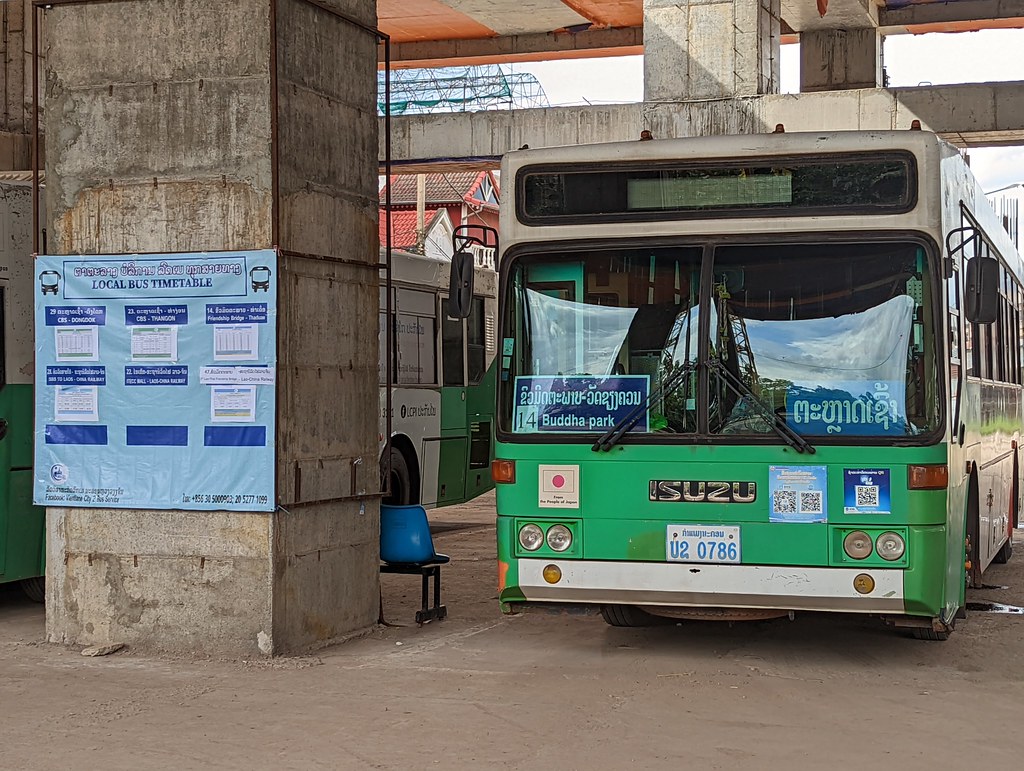

Something strange happened just after the bus left the station; an elderly man was asked by the bus attendant to leave and the other locals was helping her to persuade him. He left reluctantly eventually but I couldn’t figure out what exactly happened there.
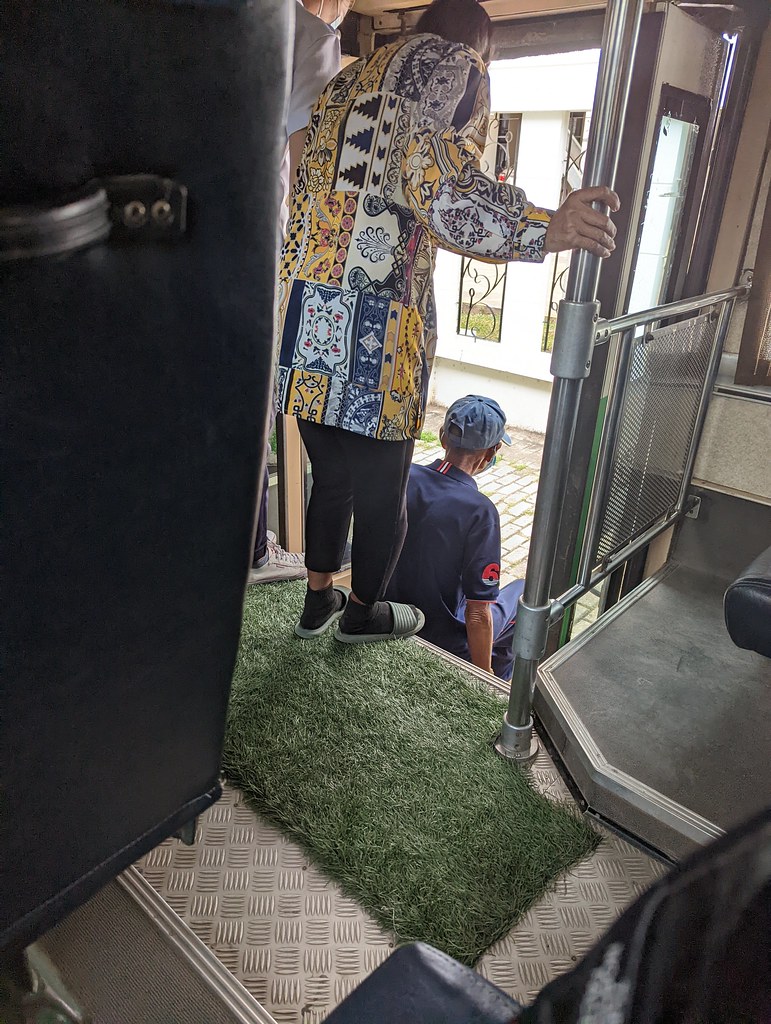
Due to the incident, we only reached the Lao immigration around 45 minutes later.

The exit immigration was a breeze and the Lao immigration officer also asked if I had my Thailand Pass (yes).
The shuttle bus ticket cost 10,000 LAK (~0.58 USD) and we had to wait a while for the bus to come.


Boarding:-


Five minutes later, we were on the Thai side.

This would be my fourth and final land border crossing for the trip. At the counter, I followed the other travellers and showed the staff my passport and Thailand Pass. He printed out some health declaration documents in Thai and asked me to sign it before directing me to the actual immigration building.

Strangely Thailand’s arrival cards weren’t readily available and I had to get one from the office located to the left of the entrance.

Unlike at Padang Besar, I wasn’t directed to a room and the officer stamped me into Thailand without any fuss. The entire immigration process at both Laos and Thailand took 45 minutes, with the majority of the time being spent waiting for the shuttle bus.
Although there was a chart displaying the tuktuk fare, I was still charged 50 THB for a shared ride to Nong Khai train station.

I was the only one from the tuktuk who alighted at the train station.

Rama X was omnipresent in Thailand.

The day SRT Train 75 arrived from Bangkok at around 5.45pm.

Next train to leave was Train 134 departing for Bangkok at 6.50pm.

An overnight 10-hour train to Bangkok in third class cost only 213 THB (~6 USD) but it probably wasn’t a good idea.
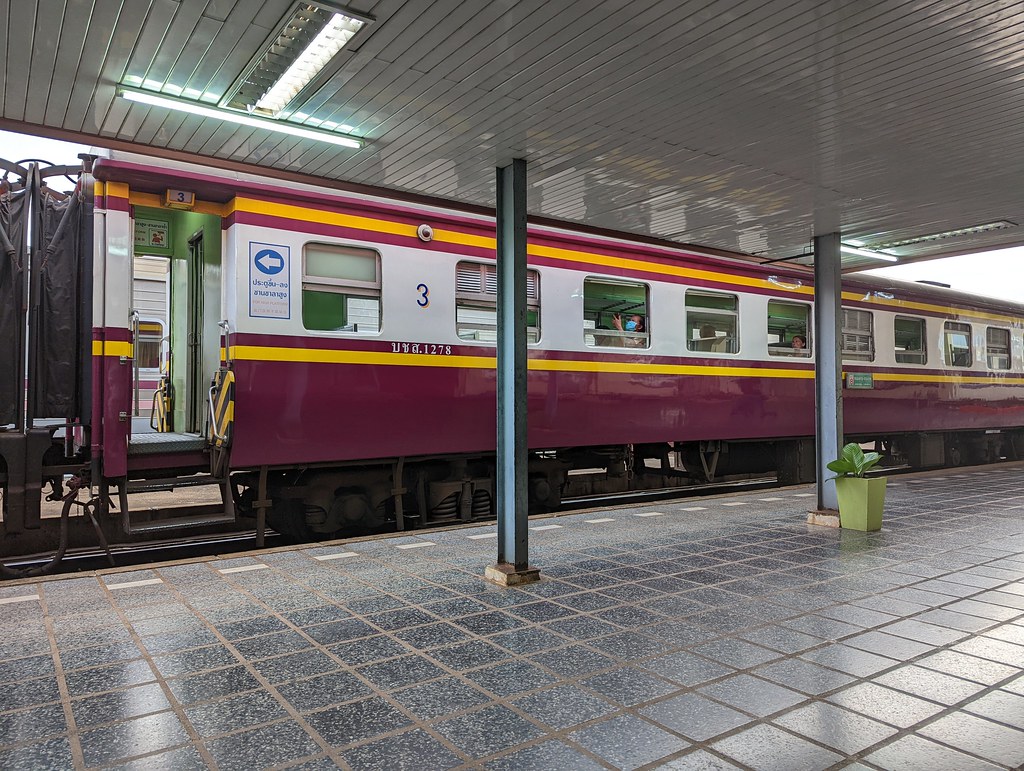
The railway staff in charge of baggage were doing some last minute work before shutting down for the day.

Once Train 134 departed, announcement was made to inform passengers on Train 26 that they could start boarding at Platform 2.
There was a short ceremony with all the train crew and one could see the crew in three different types of uniforms.

Walking across the train tracks would always be a novelty.

Found my carriage:-
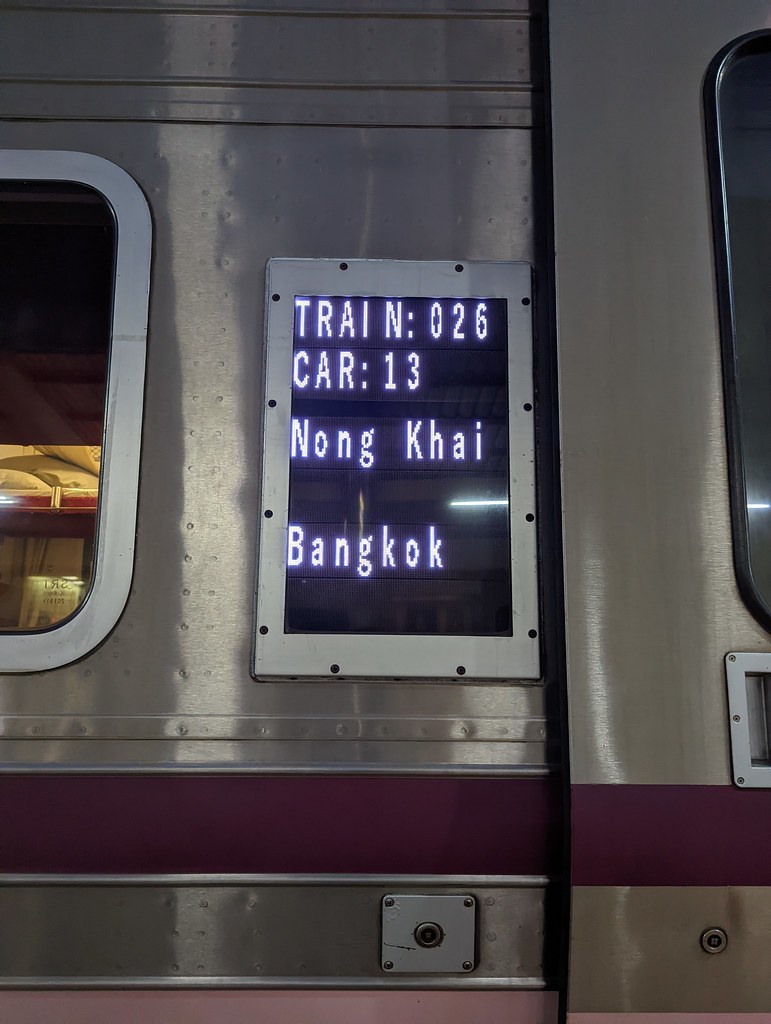
Service: State Railway of Thailand Special Express CNR 26 Aircon Sleeper 2nd Class Car 13 Seat 28
Depart: Nong Khai 7.40pm
Arrive: Bang Sue Junction 5.30am
Duration: 9h50m
Distance: ~614km
Cost: 994 THB (~28 USD)
It’s only my own personal opinion but I think that there’s no better way to travel between Vientiane (Nong Khai) and Bangkok. While it’s definitely not the fastest, train travel was a very relaxing way to travel and I also saved on a night’s stay. Being a weekday, the carriage was probably no more than half full throughout.

All tucked in and ready to sleep.

I fall asleep listening to podcast and woke up around half an hour away from my destination. The train arrived slightly early at Bang Sue Junction and I actually wished that the train was delayed so that I could relax longer on the train.

Once I alighted, there were motorcycle taxi drivers offering their services. As I was in no hurry, I decided to wait out a bit for the MRT service to start for the day.
Bang Sue Junction is a very busy station and I got to see quite a few trains arriving and departing.

Across the road was the new Bang Sue Grand Station.

It was a strategic move to stop at Bang Sue Junction because the hotel that I booked was three stops away on MRT Blue Line. The fare was only 20 THB (~0.57 USD).

There was a porridge place opposite where I would be staying and it was already open at 7am. The very satisfying bowl of pork porridge with two patongko (or youtiao in Chinese) and a drink came to 68 THB (~1.93 USD).

I booked The Quarter Ladphrao at 47.90 SGD (~35 USD) through Klook for my final night in Bangkok. It was chosen for its location as it would be quite easy to take public transport from there to the airport next day.

Unfortunately it was really too early to check-in and the room would only be ready at 2pm. Luckily, I could leave my bag with the concierge.
When the nearby Central Ladprao mall opened at 10am, I headed there and checked out the cinema showtimes. I purchased the ticket first (190 THB or ~5.40 USD) and despite the plethora of food choices, I ended up with a KFC meal (149 THB or ~4.30 USD) as early lunch.
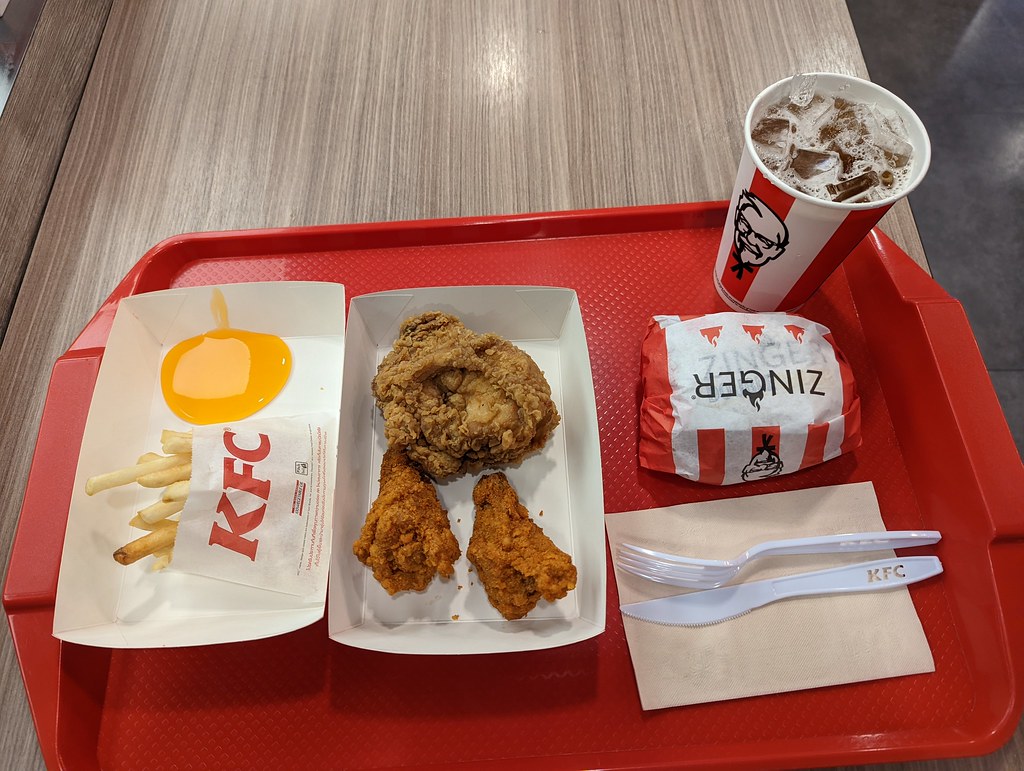

It was pretty empty on a weekday and Thailand still enforced safe-distancing measures within the cinema halls.

I had to say that Top Gun: Maverick was a very entertaining action movie with a very predictable storyline. American heroes always win at the end in Hollywood, period.
The room was ready for check-in by the time the movie ended. During check-in, the hotel staff requested 1,000 THB cash as deposit which I didn’t have. They were happy to accept my credit details as an alternative though.
Honestly I felt that they could easily charge more and I was very happy with the room quality.


The room had a nice view out of the window as well.

My final evening in Bangkok was spent over Isaan food with my friends. It was once again great catching up and I am already looking forward to my next trip to Thailand.
Distance travelled so far: ~4,036km
Segment 8: Bangkok to Singapore
For some unknown reason, I had been waking up early the entire trip. As breakfast wasn’t included in the room rate, I headed across the road for more porridge. My order this morning was a bit more extravagant; I ordered prawns and century egg to be added to the pork porridge and four patongkos, double of previous day’s order (102 THB or ~2.9 USD).

My flight to Singapore would depart from Don Mueang Airport and the bus stop was a short 5 minutes’ walk from the hotel.


I only needed to wait for a few minutes before Bus A1 arrived and the fare was only 30 THB (~0.85 USD).

The bus traveled by expressway the entire way and it only took around 20 minutes to arrive at the airport. Don Mueang Airport (DMK) was Bangkok’s major airport for most of the 20th century and was temporarily retired when Suvarnabhumi Airport (BKK) was opened in 2006. However, it had to be reopened for some domestic flights the following year and in 2012, low-cost airlines were encouraged to move back there due to capacity constraints at Suvarnabhumi.

The flights operating out of DMK were mostly domestic ones.

There was no queue when I was checking in and I was assigned one of the worst seats possible – 21E.

With plenty of time, I went to check out the lunch options at the newer domestic terminal.

There was a big food court and I chose to have some Thai fishball noodle soup (80 THB or ~2.3 USD). Apparently it is a branch of a famous stall in town but it’s probably more expensive at the airport.

Ain’t too bad for the final meal.

After clearing immigration and security, I made my way to Gate 24 and along the way saw AK883 being prepared for departure later.

The international flights were mostly operated by AirAsia group of airlines.

HS-BBM would be ferrying me home this afternoon.



The air ticket was booked one week earlier when I realised that the air ticket cost was getting expensive due to Singapore’s school holidays. I entertained thoughts of going back overland as well but I reckoned that I might be sick of trains by the end of the trip.
Service: Thai AirAsia FD359 Seat 21E
Depart: Bangkok Don Mueang (DMK) 1.05pm
Arrive: Singapore Changi (SIN) 4.30pm
Duration: 2h25m
Distance: 893 miles
Plane model / registration: A320-216 / HS-BBM
Cost: 3,750 THB (~107 USD)
Maps generated by the Great Circle Mapper – copyright © Karl L. Swartz.
I took a quick picture out of the window before the arrival of my seat mate in 21F.

The seat pocket only had the safety card.



The plane pushed back ahead of time at 12.59pm and we were airborne within 10 minutes. The flight was probably 90% full.

We landed in Singapore ahead of time and reached Gate D36 at around 4.15pm. It was a busy afternoon at Terminal 1 and it was really nice to see normalcy finally returning to Changi Airport. I still managed to clear the immigration within 20 minutes of disembarking the plane and with that, this whirlwind trip came to an end.

10 Random Thoughts from The Trip
- There are many good deals for hotels in Bangkok and Kuala Lumpur at the moment (as of June 2022).
- I will visit Vang Vieng the next time I am in Laos.
- Singapore is geographically in Southeast Asia but does at times feel a world away from the other countries in the region.
- Tourists are returning to Southeast Asia but the industry’s true recovery really depends on when Chinese tourists can travel again.
- China is the king of exporting rail technology to Southeast Asia. All the train carriages that I was on were manufactured in China and the Chinese also built the entire railway system in Laos.
- Lao-China Railway is still not equipped to handle foreign tourists. No online ticket booking in the 21st century is honestly unforgivable.
- Mobile internet speed is good in most built-up area but close to unusable in the countryside.
- We are all feeling the impacts of war in Ukraine, from Malaysian ban of fresh chicken exports to fuel shortage in Laos.
- It’s actually possible to travel from Singapore to Boten within 62 hours if there are no delays and all stars are aligned. The reverse direction can be done within the same amount of time too.
- What should be my next adventure?



